医学文献中英文对照
医学基本中英文对照

1、颅脑大脑 cerebrum大脑纵裂 longitudinal cerebral fissure大脑皮质 cerebral大脑镰 falx cerebri大脑导水管,中脑水管 cerebral aqueduct中脑 midbrain, mesencephalon小脑 cerebellum小脑幕 tentorium cerebelli丘脑,视丘 thalmus延髓 medulla oblongata侧脑室 lateral ventricle第三脑室 third ventricle第四脑室 fourth ventricle第五脑室 fifth ventricle脑桥,桥脑 pons脑干 brain stem间脑 diencephalon中间块 intermidiate mass尾状核 caudate nucleus脉络丛 choroid plexus胼胝体 corpus callosum脑岛,岛叶 insula大脑脚 cerebral peduncles大脑外侧沟(窝、裂) lateral sulcus , sylvius fissure 穹窿 fornix透明隔 septum pellucidum透明隔腔 cavity of septum pellucidum额叶 frontal lobe顶叶 parietal lobe枕叶 occipital lobe颞叶 temporale lobe缘叶 limbic lobe大脑动脉环 Willi's artery circle大脑前动脉 anterior cerebral artery大脑中动脉 middle cerebral artery大脑后动脉 posterior cerebral artery基底动脉 basilar artery后交通支(动脉) posterior communicating branch颅前窝,凹 anterior cranial fossa颅中窝,凹 middle cranial fossa颅后窝,凹 posterior cranial fossa2、眼、面颈、涎腺、乳腺、胸肺眼球 optic bulb ,eyeball角膜 cornea前房 anterior chamber虹膜 iris睫状体 ciliary body视网膜 retina脉络膜 choroid巩膜 sclera房水 aqueous humour玻璃体 vitreous玻璃体膜 hyaloid membrae晶状体 lens(眼)直肌 recti muscles视神经 optic nerve眶上动脉 supraorbital artery眼动脉 ophthalmic artery视网膜中央动脉 central retinal artery睫状后长(短)动脉posterior long (short) ciliaryartery泪腺动脉 lacrimal gland artery滑车上动脉 supratrochlear artery眼静脉 ophthalmic vein眶上静脉 suprorbital vein滑车上静脉 supratrochlear vein视网膜中央静脉 central retinal vein涡状静脉 vorticose veins眼眶 orbit结膜 conjunctiva唾液腺、涎腺 salivary gland腮腺 parotid (gland)颌下腺 submaxillary gland舌下腺 sublingual gland甲状腺 thyroid (gland )甲状旁腺 parathyroid (gland )上颌窦 maxillary sinus气管 trachea乳腺 breast, mammary gland额 front枕 occiput颞 temples颊 cheek胸廓、胸腔 thorax, thorax cavity肋骨 ribs, costae肋软骨costal cartilages胸骨 sternum乳腺组织 breast tissue悬韧带suspensory ligament, Copper's ligament乳腺后组织 retromammary tissue横膈 diaphragm颈总动脉 common carotid artery颈外动脉 external carotid artery颈内动脉 internal carotid artery椎动脉 vertebral artery无名动脉 innominate artery颈内静脉 internal jugular vein甲状腺上动脉 superior thyroid artery乳房内动脉 internal mammary artery3、腹部血管、周围血管腹主动脉 abdominal aorta腹腔动脉 celiac artery肠系膜上动脉 superior mesenteric artery肠系膜下动脉 inferior mesenteric artery肝总动脉 common hepatic artery肝动脉 hepatic artery胃左动脉 left gastric artery胃十二指肠动脉 gastroduodenal artery脾动脉 splenic artery肾动脉 renal artery卵巢动脉 ovarian artery髂总动脉 common iliac artery髂内动脉 internal iliac artery髂外动脉 external iliac artery锁骨下动脉 subclavian artery椎动脉 vertebral artery乳房内动脉 internal mammary artery颈内静脉 internal jugular vein颈外静脉 external jugular vein奇静脉 azygos vein大隐静脉 great saphenous vein下腔静脉 inferior vena cava门静脉 portal vein肠系膜上静脉 superior mesenteric vein肝静脉 hepatic vein肾静脉 renal vein腰静脉 lumbar vein精索静脉 spermatic vein肾弓形动脉 renal arcuate arteries股动脉 femoral artery肱动脉 humeral artery桡动脉 radial artery尺动脉ulnar artery面动脉 facial artery锁骨下动脉 subclavian artery颈浅动脉 superficial cervical artery颞浅动脉 superficial temporal artery4、肝、胆、胰、脾、泌尿男生殖肝左叶left liver lobe(LL)肝右叶right liver lobe(RL)尾状叶 caudate lobe(CL)方叶 quadrate lobe(QL)附垂叶Riedel's lobe胆囊gallbladder(GB)胆囊管 cystic duct(CD)肝管 hepatic duct(HD)胆总管common bile duct (CBD)肝门 porta hepatis胆囊窝 gallbladder forssa肝圆韧带 hepatoumbilical ligament, round ligament肝镰状韧带 falciform ligament肝静脉韧带 venose ligament胆管、胆道 bile duct(BD)螺旋状瓣 spiral valve肝总管 common hepatic duct肝外胆管 extrahepatic duct乏特壶腹 Vater's ampulla胰腺 pancreas胰管 pancreatic duct , Wirsung's duct副胰管 Santorini duct胰颈 neck of pancreas胰体 body of pancreas胰尾 tail of pancreas钩突 uncinate process脾 spleen脾门 splenic hilum肾周脂肪 perinephrit fat集合系统 collective system肾 kedney肾盂 renal calyes锥体 pyramids肾柱 renal colums肾上腺 adrenal gland输尿管 ureters, ureteral , uretero膀胱 urinary bladder , bladder尿道 urethra睾丸 testis附睾 epididymis鞘膜 tunica vagialis, vagina tunic白膜 tunica albuginea , albuginea输精管 ductus deferens, deferent duct精囊 vesiculae seminals, seminal vesicle射精管 ejaculatory ducts阴囊 scrotum, scrotal sac精索 spermatic cord腹股沟 inguen前列腺 prostate5、妇产科子宫 uterus输卵管 uterine tube, oviduct卵巢 ovary, ovaries子宫颈 cervix子宫腔 uterine canal子宫内膜 endometriosis子宫直肠陷凹 rectouterine fossa子宫内口 internal ostium of the uterus子宫口 orifice of the uterus阴道 vagina胚胎 embryo卵黄囊 yolk sac羊膜 amnion蜕膜 decidua绒毛 villus绒毛膜 chorion胎盘 placenta胎儿 fetus胎心 fetal heart胎动fetal movement, feta motion胎儿脊柱 fetal spine胎儿胃泡 fetal stomach bubble胎儿胸部fetal thorax胎儿肾 fetal kidney胎儿肢体 fetal limb脐带 umbilical cord卵泡,滤泡 follicle附件 adnexa羊水 amniotic fluid宫内节育器 intrauterine device妊娠囊 gestational sac顶臀长度 crown-rump length双顶径 biparietal diameter胎头指数 cephalic index枕额径 occipito-frontal diameter头围 head circumference胸围 thoracic circumference腹围 abdominal circumference小脑径 cerebellum diameter头(径)指数 cephalic index双眼间距 ocular distance腹部横径 transverse trunk diameter腹部前后径 anteroposterior trunk diameter椎骨长度(胸6~腰3)length of vertebrae脊柱 spine, vertebral colum股骨长度 femur length肱骨长度 humerus length胎儿体重 fetal weight脐动脉 umbilical artery脐静脉 umbilical vein胎盘 placenta孕周 gestational week孕龄 gestational age。
365编号外国文献的中英文对照版
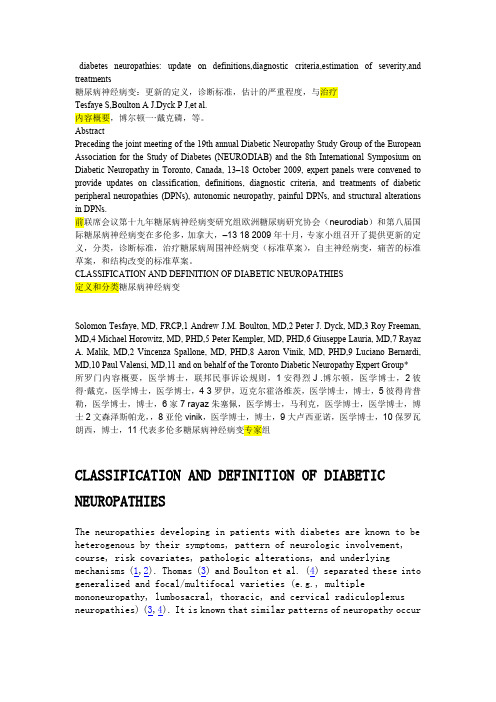
diabetes neuropathies: update on definitions,diagnostic criteria,estimation of severity,and treatments糖尿病神经病变:更新的定义,诊断标准,估计的严重程度,与治疗Tesfaye S,Boulton A J.Dyck P J,et al.内容概要,博尔顿一·戴克磷,等。
AbstractPreceding the joint meeting of the 19th annual Diabetic Neuropathy Study Group of the European Association for the Study of Diabetes (NEURODIAB) and the 8th International Symposium on Diabetic Neuropathy in Toronto, Canada, 13–18 October 2009, expert panels were convened to provide updates on classification, definitions, diagnostic criteria, and treatments of diabetic peripheral neuropathies (DPNs), autonomic neuropathy, painful DPNs, and structural alterations in DPNs.前联席会议第十九年糖尿病神经病变研究组欧洲糖尿病研究协会(neurodiab)和第八届国际糖尿病神经病变在多伦多,加拿大,–13 18 2009年十月,专家小组召开了提供更新的定义,分类,诊断标准,治疗糖尿病周围神经病变(标准草案),自主神经病变,痛苦的标准草案,和结构改变的标准草案。
医学英语文献选读2部分文章全文翻译
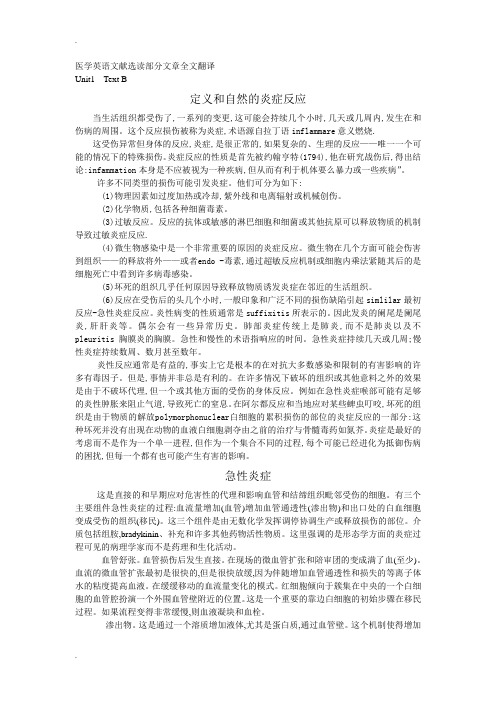
医学英语文献选读部分文章全文翻译Unit1 Text B定义和自然的炎症反应当生活组织都受伤了,一系列的变更,这可能会持续几个小时,几天或几周内,发生在和伤病的周围。
这个反应损伤被称为炎症,术语源自拉丁语inflammare意义燃烧.这受伤异常但身体的反应,炎症,是很正常的,如果复杂的、生理的反应——唯一一个可能的情况下的特殊损伤。
炎症反应的性质是首先被约翰亨特(1794),他在研究战伤后,得出结论:infammation本身是不应被视为一种疾病,但从而有利于机体要么暴力或一些疾病”。
许多不同类型的损伤可能引发炎症。
他们可分为如下:(1)物理因素如过度加热或冷却,紫外线和电离辐射或机械创伤。
(2)化学物质,包括各种细菌毒素。
(3)过敏反应。
反应的抗体或敏感的淋巴细胞和细菌或其他抗原可以释放物质的机制导致过敏炎症反应.(4)微生物感染中是一个非常重要的原因的炎症反应。
微生物在几个方面可能会伤害到组织——的释放将外——或者endo -毒素,通过超敏反应机制或细胞内乘法紧随其后的是细胞死亡中看到许多病毒感染。
(5)坏死的组织几乎任何原因导致释放物质诱发炎症在邻近的生活组织。
(6)反应在受伤后的头几个小时,一般印象和广泛不同的损伤缺陷引起simlilar最初反应-急性炎症反应。
炎性病变的性质通常是suffixitis所表示的。
因此发炎的阑尾是阑尾炎,肝肝炎等。
偶尔会有一些异常历史。
肺部炎症传统上是肺炎,而不是肺炎以及不pleuritis胸膜炎的胸膜。
急性和慢性的术语指响应的时间。
急性炎症持续几天或几周;慢性炎症持续数周、数月甚至数年。
炎性反应通常是有益的,事实上它是根本的在对抗大多数感染和限制的有害影响的许多有毒因子。
但是,事情并非总是有利的。
在许多情况下破坏的组织或其他意料之外的效果是由于不破坏代理,但一个或其他方面的受伤的身体反应。
例如在急性炎症喉部可能有足够的炎性肿胀来阻止气道,导致死亡的窒息。
在阿尔都反应和当地应对某些蜱虫叮咬,坏死的组织是由于物质的解放polymorphonuclear白细胞的累积损伤的部位的炎症反应的一部分:这种坏死并没有出现在动物的血液白细胞剥夺由之前的治疗与骨髓毒药如氮芥。
各类医学中英文对照
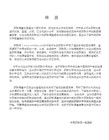
eclipse period|[细胞生长的]隐蔽期
eclipsed conformation|重叠构象
eclosion hormone|蜕壳激素[见于昆虫]
ecological isolation|生态隔离
electrical synapse|电突触
electrical transmission|电传递
electrically facilitated flow|电易化流动,电促流动
electroblotting|电印迹
electroblotting device|电印迹仪,电印迹装置
early promoter|早期启动子[有时特指病毒]
early protein|早期蛋白[有时特指病毒]
early transcription|早期转录[有时特指病毒]
eburicoic acid|齿孔酸
ecdysis|蜕皮
ecdyson|蜕皮激素[见于昆虫等节肢动物]
E rosette|E(玫瑰)花结[E表示红细胞erythrocyte]
E rosette test|E(玫瑰)花结试验
EA rossette|EA(玫瑰)花结[E表示红细胞erythrocyte,A表示抗体antibody]
EAC rossette|EAC(玫瑰)花结[E表示红细胞erythrocyte,A表示抗体antibody,C表示补体complement]
Eubacteria (真细菌):组成原核生物中的大部分。
Euchromatin (常染色体):间期核内除了异染色质之外的所有基因组。
Evolutionary clock (进化钟):特定基因突变积累的速度定义。
医学文献翻译(中英对照)
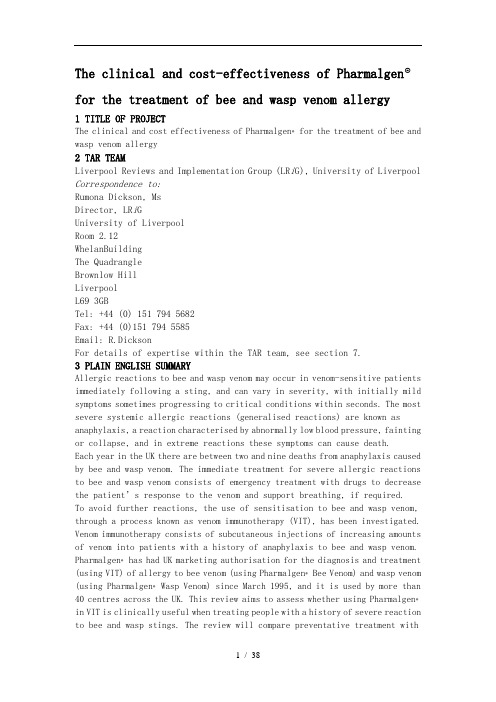
The clinical and cost-effectiveness of Pharmalgen®for the treatment of bee and wasp venom allergy1 TITLE OF PROJECTThe clinical and cost effectiveness of Pharmalgen®for the treatment of bee and wasp venom allergy2 TAR TEAMLiverpool Reviews and Implementation Group (LR i G), University of Liverpool Correspondence to:Rumona Dickson, MsDirector, LR i GUniversity of LiverpoolRoom 2.12WhelanBuildingThe QuadrangleBrownlow HillLiverpoolL69 3GBTel: +44 (0) 151 794 5682Fax: +44 (0)151 794 5585Email: R.DicksonFor details of expertise within the TAR team, see section 7.3 PLAIN ENGLISH SUMMARYAllergic reactions to bee and wasp venom may occur in venom-sensitive patients immediately following a sting, and can vary in severity, with initially mild symptoms sometimes progressing to critical conditions within seconds. The most severe systemic allergic reactions (generalised reactions) are known as anaphylaxis, a reaction characterised by abnormally low blood pressure, fainting or collapse, and in extreme reactions these symptoms can cause death.Each year in the UK there are between two and nine deaths from anaphylaxis caused by bee and wasp venom. The immediate treatment for severe allergic reactions to bee and wasp venom consists of emergency treatment with drugs to decrease the patient’s response to the venom and support breathing, if required.To avoid further reactions, the use of sensitisation to bee and wasp venom, through a process known as venom immunotherapy (VIT), has been investigated. Venom immunotherapy consists of subcutaneous injections of increasing amounts of venom into patients with a history of anaphylaxis to bee and wasp venom. Pharmalgen®has had UK marketing authorisation for the diagnosis and treatment (using VIT) of allergy to bee venom (using Pharmalgen®Bee Venom) and wasp venom (using Pharmalgen®Wasp Venom) since March 1995, and it is used by more than 40 centres across the UK. This review aims to assess whether using Pharmalgen®in VIT is clinically useful when treating people with a history of severe reaction to bee and wasp stings. The review will compare preventative treatment withPharmalgen®to other treatment options, including high dose antihistamines, advice on the avoidance of bee and wasp stings and adrenaline auto-injector prescription and training. If suitable data are available, the review will also consider the cost effectiveness of using Pharmalgen®for VIT and other subgroups including children and people at high risk of future stings or severe allergic reactions to future stings.4 DECISION PROBLEM4.1 Clarification of research question and scopePharmalgen®is used for the diagnosis and treatment of immunoglobin E (IgE)-mediated allergy to bee and wasp venom. The aim of this report is to assess whether the use of Pharmalgen®is of clinical value when providing VIT to individuals with a history of severe reaction to bee and wasp venom and whether doing so would be considered cost effective compared with alternative treatment options available in the NHS.4.2 BackgroundBees and wasps form part of the order Hymenoptera (which also includes ants), and within this order the species that cause the most frequent allergic reactions are the Vespidae (wasps, yellow jackets and hornets), and the Apinae (honeybees).1Bee and wasp stings contain allergenic proteins. In wasps, these are predominantly phospholipase A1,2 hyaluronidase2 and antigen 5,3 and in bees are phospholipase A2 and hyaluronidase.4 Following an initial sting, a type 1 hypersensitivity reaction may occur in some individuals which produces the IgE antibody. This sensitises cells to the allergen, and any subsequent exposure to the allergen may cause the allergen to bind to the IgE molecules, which results in an allergic reaction.These allergens typically produce an intense, burning pain followed by erythema (redness) and a small area of oedema (swelling) at the site of the sting. The symptoms produced following a sting can be classified into non-allergic reactions, such as local reactions, and allergic reactions, such as extensive local reactions, anaphylactic systemic reactions and delayed systemic reactions.5-6 Systemic allergic reactions may occur in venom-sensitive patients immediately following a sting,7 and can vary in severity, with initially mild symptoms sometimes progressing to critical conditions within seconds.1The most severe systemic allergic reaction is known as anaphylaxis. Anaphylactic reactions are of rapid onset (typically up to 15 minutes post sting) and can manifest in different ways. Initial symptoms are usually cutaneous followed by hypotension, with light-headedness, fainting or collapse. Some people develop respiratory symptoms due to an asthma-like response or laryngeal oedema. In severe reactions, hypotension, circulatory disturbances, and breathing difficulty can progress to fatal cardio-respiratory arrest.Anaphylaxis occurs more commonly in males and in people under 20 years of ageand can be severe and potentially fatal.84.3 EpidemiologyIt is estimated that the prevalence of wasp and bee sting allergy is between 0.4% and 3.3%.9 The incidence of systemic reactions to wasp and bee venom is not reliably known, but estimates range from 0.15-3.3%,10-11 Systemic allergic reactions are reported by up to 3% of adults, and almost 1% of children have a medical history of severe sting reactions.9, 12 After a large local reaction, 5–15% of people will go on to develop a systemic reaction when next stung.13 In people with a mild systemic reaction, the risk of subsequent systemic reactions is thought to be about 18%.13 Hymenoptera venom are one of the three main causes of fatal anaphylaxis in the USA and UK.14-15 Insect stings are the second most frequent cause of anaphylaxis outside of medical settings.16 Between two and nine people in the UK die each year as a result of anaphylaxis due to reactions to wasp and bee stings.17 Once an individual has experienced an anaphylactic reaction, the risk of having a recurrent episode has been estimated to be between 60% and 79%.13In 2000, the register of fatal anaphylactic reactions in the UK from 1992 onwards was reported by Pumphrey to determine the frequency at which classic manifestations of fatal anaphylaxis are present.18 Of the 56 post-mortems carried out, 19 deaths were recorded as reactions to Hymenoptera venom (33.9%). A retrospective study in 2004 examined all deaths from anaphylaxis in the UK between 1992 and 2001, and estimated 22.19% to be reactions to Hymenoptera venom (47/212). This further breaks down into 29/212 (13.68%) as reactions to wasp stings, and 4/212 (1.89%) as reactions to bee stings. The remaining 14/212 were unidentified Hymenoptera stings (6.62%).194.4 Current diagnostic optionsCurrently, individuals can be tested to determine if they are at risk of systemic reactions to bee and wasp venom. The primary diagnostic method for systemic reactions to bee and/or wasp stings is venom skin testing.Skin testing involves intradermal injection with the five Hymenoptera venom protein extracts, with venom concentrati ons in the range of 0.001 to 1.0 μg/ml. This establishes the minimum concentration giving a positive result (a reaction occurring in the individual). As venom tests show unexplained variability over time,20 and as negative skin tests can occur following recent anaphylaxis, it is recommended that tests be repeated after 1 to 6 months.21Other methods of diagnosis in patients following an anaphylactic reaction include radioallergosorbent test (RAST), which detects allergen-specific IgE antibodies in serum. This test is less sensitive than skin testing but is useful when skin tests cannot be done, for example in patients with skin conditions.22-234.5 Current treatment optionsPreventative treatments include education on how to avoid bee and wasp venom,and prescription of high dose antihistamines. Patients with a history of moderate local reactions should be provided with an emergency kit,24 containing aH1-blocking antihistamine and a topical corticosteroid for immediate use following a sting. Patients with a history of anaphylaxis should be provided with an emergency kit containing a rapid-acting H1-blocking antihistamine, an oral corticosteroid and an auto-injector for self administration, containing epinephrine.Injected epinephrine (a sympathomimetic drug which acts on both alpha and beta receptors) is regarded as the emergency treatment of choice for cases of acute anaphylaxis as a result of Hymenoptera stings.25 For adults, the recommended dose is between 0.30 mg/ml and 0.50 mg/ml I.M, and 0.01 ml/kg I.M. for children. Individuals with a history of anaphylactic reactions are recommended to carry auto injectors containing epinephrine (commonly known as EpiPen®, Adrenaclick®, Anapen®or Twinject®). These are intended for immediate self-administration by individuals with a history of hypersensitivity to Hymenoptera stings and other allergens.Preventive measures following successful treatment of a systemic allergic reaction to Hymenoptera venom consists of either allergen avoidance or specific allergen immunotherapy, known as VIT. Venom immunotherapy is considered to be a safe and effective treatment.26 Currently, VIT can be used with several regimes, including Pharmalgen®(manufactured by ALK Abello, and licensed in the UK), Aquagen®and Alutard SQ®(both manufactured by ALK Abello and unlicensed in the UK but licensed in some parts of Europe), VENOMENHAL®(HAL Allergy, Leiden, Netherlands, unlicensed in the UK), Alyostal®(Stallergenes, Antony Cedex, France, unlicensed in the UK), and Venomil®(Hollister-Stier Laboratories LLC, unlicensed in the UK). Venom immunotherapy is recommended to prevent future systemic reactions. It is recommended that VIT is considered ‘when positive test results for specific IgE antibodies correlate with suspected triggers and pa tient exposure’.27 Venom immunotherapy consists of subcutaneous injections of increasing amounts of venom, and treatment is divided into two periods: the build up phase and maintenance phase. Venom immunotherapy is now the standard therapy for Hymenoptera sting allergy,28 and is a model for allergen-specific therapy,29-30 with success rates (patients who will remain anaphylaxis free) being reported as more than 98% in some studies.4, 31 There are now 44 centres across the UK which provide VIT to people for bee and wasp sting allergy. Venom immunotherapy is normally discontinued after 3 to 5 years, but modifications may be necessary when treating people with intense allergen exposure (such as beekeepers) or those with individual risk factors for severe reactions. There is no method of assessing which patients will be at risk of further anaphylactic reactions following administration of VIT and those who will remain anaphylaxis free in the long term following VIT.27Local or systemic adverse reactions may occur as a result of VIT. They normally develop within 30 minutes of the injection. Each patient is monitored closely following each injection to check for adverse reactions. Progression to anincreased dose only occurs if the previous dose is fully tolerated.4.6 The technologyPharmalgen®is produced by ALK Abello, and has had UK marketing authorisation for the diagnosis (using skin testing/intracutaneous testing) and treatment (using VIT) of IgE-mediated allergy to bee venom (Pharmalgen®Bee Venom) and wasp venom (Pharmalgen®Wasp Venom) since March 1995 (marketing authorisation number PL 10085/0004). The active ingredient is partially purified freeze dried Vespula spp. venom in Pharmalgen®Wasp Venom and freeze dried Apis mellifera venom in Pharmalgen®Bee Venom, each provided in powder form for solution for injection.Before treatment is considered, allergy to bee or wasp venom must be confirmed by case history and diagnosis. Treatment with Pharmalgen®Bee or Wasp Venom is performed by subcutaneous injections. The treatment is carried out in two phases: the initial phase and the maintenance phase.In the build up phase, the dose is increased stepwise until the maintenance dose (the maximum tolerable dose before an allergic reaction) is achieved. ALK Abello recommends the following dosage proposals: conventional, modified rush (clustered) and rush updosing. In conventional updosing, the patient receives one injection every 3-7 days. In modified rush (clustered) updosing, the patient receives 2-4 injections once a week. If necessary this interval may be extended up to two weeks. The 2-4 injections are given with an interval of 30 minutes. In rush updosing, while being hospitalised the patient receives injections with a 2-hour interval. A maximum of four injections per day may be given in the initial phase.The build up phase ends when the individual maintenance dose has been attained and the interval between the injections is increased to 2, 3 and 4 weeks. This is called the maintenance phase, and the maintenance dose is then given every 4 weeks for at least 3 years.Contra-indications to VIT treatment are immunological diseases (e. g. immune complex diseases and immune deficiencies); chronic heart/lung diseases; treatment with β-blockers; severe eczema. Side effects include superficial wheal and flare due to shallow injection; local swelling (which may be immediate or delayed up to 48 hours); mild general reactions such as urticaria, erythema, rhinitis or mild asthma; moderate or severe general reactions such as more severe asthma, angioedema or an anaphylactic reaction with hypotension and respiratory embarrassment; anaphylaxis (often starting with erythema and pruritus, followed by urticaria, angioedema, nasal or pharyngial congestion, wheezing, dyspnoea, nausea, hypotension, syncope, tachycardia or diarrhoea). 324.7 Objectives of the HTA projectThe aim of this review is to assess the clinical and cost effectiveness of Pharmalgen®in providing immunotherapy to individuals with a history of type 1 IgE-mediated systemic allergic reaction to bee and wasp venom. The review willconsider the effectiveness of Pharmalgen®when compared to alternative treatment options available in the NHS, including advice on the avoidance of bee and wasp stings, high dose antihistamines and adrenaline auto-injector prescription and training. The review will also examine the existing health economic evidence and identify the key economic issues related to the use of Pharmalgen®in UK clinical practice. If suitable data are available, an economic model will be developed and populated to evaluate if the use of Pharmalgen®for the treatment of bee and wasp venom allergy, within its licensed indication, would be a cost effective use of NHS resources.5 METHODS FOR SYNTHESISING CLINICAL EFFECTIVENESS EVIDENCE5.1 Search strategyThe major electronic databases including Medline, Embase and The Cochrane Library will be searched for relevant published literature. Information on studies in progress, unpublished research or research reported in the grey literature will be sought by searching a range of relevant databases including National Research Register and Controlled Clinical Trials. A sample of the search strategy to be used for MEDLINE is presented inAppendix 1.Bibliographies of previous systematic reviews, retrieved articles and the submissions provided by manufacturers will be searched for further studies.A database of published and unpublished literature will be assembled from systematic searches of electronic sources, hand searching, contacting manufacturers and consultation with experts in the field. The database will be held in the Endnote X4 software package.Inclusion criteriaThe inclusion criteria specified in Table 1 will be applied to all studies after screening. The inclusion criteria were selected to reflect the criteria described in the final scope issued by NICE for the review. However, as there is likely to be a limited amount of RCT data, the inclusion criteria of study design may be expanded to include comparative studies and descriptive cohorts. The clinical and cost effectiveness of Pharmalgen®for the treatment of bee and wasp venom allergy Page 11 of 21Table 1: Inclusion criteria Intervention(s) Pharmalgen®for the treatment of bee and wasp venom allergy,Population(s) People with a history of type 1 IgE-mediatedsystemic allergic reactions to:wasp venom and/or bee venomComparators Alternative treatment options available inthe NHS, without venom immunotherapyincluding:advice on the avoidance of bee and wasp venom,high-dose antihistamines,adrenaline auto-injector prescription andtrainingStudy design Randomised controlled trialsSystematic reviewsOutcomes Outcome measures to be considered include:number and severity of type 1 IgE-mediatedsystemic allergic reactionsmortalityanxiety related to the possibility of futureallergic reactionsadverse effects of treatmenthealth-related quality of lifeOther considerations If the evidence allows, considerations willbe given to subgroups of people, according totheir:risk of future stings (as determined, forexample, by occupational exposure)risk of severe allergic reactions to futurestings (as determined by such factors asbaseline tryptase levels and co-morbidities)If the evidence allows, the appraisal willconsider separately people who have acontraindication to adrenaline.If the evidence allows, the appraisal willconsider children separately.Two reviewers will independently screen all titles and abstracts of papers identified in the initial search. Discrepancies will be resolved by consensus and where necessary a third reviewer will be consulted. Studies deemed to be relevant will be obtained and assessed for inclusion. Where studies do not meet the inclusion criteria they will be excluded.Data extraction strategyData relating to study design, findings and quality will be extracted by one reviewer and independently checked for accuracy by a second reviewer. Study details will be extracted using a standardised data extraction form. If time permits, attempts will be made to contact authors for missing data. Data from studies presented in multiple publications will be extracted and reported as a single study with all relevant other publications listed.Quality assessment strategyThe quality of the clinical-effectiveness studies will be assessed accordingto criteria based on the CRD’s guidance for undertaking reviews in healthcare.33-34 The quality of the individual clinical-effectiveness studies will be assessed by one reviewer, and independently checked for agreement by a second. Disagreements will be resolved through consensus and if necessary a third reviewer will be consulted.Methods of analysis/synthesisThe results of the data extraction and quality assessment for each study will be presented in structured tables and as a narrative summary. The possible effects of study quality on the effectiveness data and review findings will be discussed. All summary statistics will be extracted for each outcome and where possible, data will be pooled using a standard meta-analysis.35 Heterogeneity between the studies will be assessed using the I2 test.34 Both fixed and random effects results will be presented as forest plots.6 METHODS FOR SYNTHESISING COST EFFECTIVENESS EVIDENCEThe economic section of the report will be presented in two parts. The first will include a standard review of relevant published economic evaluations. If appropriate and data are available, the second will include the development of an economic model. The model will be designed to estimate the cost effectiveness of Pharmalgen®for VIT in individuals with a history of anaphylaxis to bee and wasp venom. This section of the report will also consider budget impact and will take account of available information on current and anticipated patient numbers and service configuration for the treatment of this condition in the NHS.6.1 Systematic review of published economic literatureThe literature review of economic evidence will identify any relevant published cost-minimisation, cost-effectiveness, cost-utility and/or cost-benefit analyses. Economic evaluations/models included in the manufacturer submission(s) will be included in the review and critiqued as appropriate.Search strategyThe search strategies detailed in section 5 will be adapted accordingly to identify studies examining the cost effectiveness of using Pharmalgen®for VIT in patients with a history of allergic reactions to bee or wasp venom. Other searching activities, including electronic searching of online health economic journals and contacting experts in the field will also be undertaken. Full details of the search process will be presented in the final report. The search strategy will be designed to meet the primary objective of identifying economic evaluations for inclusion in the cost-effectiveness literature review. At the same time, the search strategy will be used to identify economic evaluations and other information sources which may include data that can be used to populate a de novo economic model where appropriate. Searching will be undertaken in MEDLINE and EMBASE as well as in the Cochrane Library, which includes the NHS Economic Evaluation Database (NHS EED).Inclusion and exclusionIn addition to the inclusion criteria outlined in Table 1, specific criteria required for the cost-effectiveness review are described in Table 2. In particular, only full economic evaluations that compare two or more options and consider both costs and consequences will be included in the review of published literature. Any economic evaluations/models included in the manufacturer submission(s) will be included as appropriate. Studies that do not meet all of the criteria will be excluded and their bibliographic details listed with reasons for exclusion.Table 2: Additional inclusion criteria (cost effectiveness) Study design Full economic evaluations that consider both costs and consequences (cost-effectiveness analysis,cost-utility analysis,cost-minimisation analysis and cost benefit analysis)Outcomes Incremental cost per life year gainedIncremental cost per quality adjustedlife year gainedData extraction strategyData relating to both study design and quality will be extracted by one reviewer and independently checked for accuracy by a second reviewer. Disagreement will be resolved through consensus and, if necessary, a third reviewer will be consulted. If time constraints allow, attempts will be made to contact authors for missing data. Data from multiple publications will be extracted and reported as a single study.Quality assessment strategyThe quality of the cost-effectiveness studies/models will be assessed according to a checklist updated from that developed by Drummond et al.36 This checklist will reflect the criteria for economic evaluation detailed in the methodological guidance developed by NICE.37 The quality of the individual cost-effectiveness studies/models will be assessed by one reviewer, and independently checked for agreement by a second. Disagreements will be resolved through consensus and, if necessary, a third reviewer will be consulted. The information will be tabulated and summarised within the text of the report.6.2 Methods of analysis/synthesisCost effectiveness review of published literatureIndividual study data and quality assessment will be summarised in structured tables and as a narrative description. Potential effects of study quality willbe discussed.To supplement findings from the economic literature review, additional cost and benefit information from other sources, including the manufacturer submission(s) to NICE, will be collated and presented as appropriate.Development of a de novo economic model by the AGa. Cost dataThe primary perspective for the analysis of cost information will be the NHS. Cost data will therefore focus on the marginal direct health service costs associated with the intervention.Quantities of resources used will be identified from consultation with experts, primary data from relevant sources and the reviewed literature. Where possible, unit cost data will be extracted from the literature or obtained from other relevant sources (drug price lists, NHS reference costs and Chartered Institute of Public Finance and Accounting cost databases).Where appropriate costs will be discounted at 3.5% per annum, the rate recommended in NICE guidance to manufacturers and sponsors of submissions. 37 b. Assessmentof benefitsA balance sheet will be constructed to list benefits and costs arising from alternative treatment options. LRiG anticipates that the main measures of benefit will be increased QALYs.Where appropriate, effectiveness and other measures of benefit will be discounted at 3.5%, the rate recommended in NICE guidance to manufacturers and sponsors of submissions. 37b. ModellingThe ability of LRiG to construct an economic model will depend on the data available. Where modelling is appropriate, a summary description of the model and a critical appraisal of key structures, assumptions, resources, data and sensitivity analysis (see Section d) will be presented. In addition, LRiG will provide an assessment of the model’s strengths and weaknesses and discuss the implications of using different assumptions in the model. Reasons for any major discrepancies between the results obtained from assessment group model and the manufacturer model(s) will be explored.The time horizon will be a patient’s lifetime in order to reflect the chronic nature of the disease.A formal combination of costs and benefits will also be performed, although the type of economic evaluation will only be chosen in light of the variations in outcome identified from the clinical- effectiveness review evidence.If data are available, the results will be presented as incremental cost per QALY ratios for each alternative considered. If sufficient data are not available to construct these measures with reasonable precision, incrementalcost-effectiveness analysis or cost-minimisation analysis will be undertaken. Any failure to meet the reference case will be clearly specified and justified, and the likely implications will, as far as possible, be quantified.d. Sensitivity analysisIf appropriate, sensitivity analysis will be applied to LRiG’s model in order to assess the robustness of the results to realistic variations in the levels of the underlying parameter values and key assumptions. Where the overall results are sensitive to a particular variable, the sensitivity analysis will explore the exact nature of the impact of variations.Imprecision inthe principal model cost-effectiveness results with respect to key parameter values will be assessed by use of techniques compatible with the modelling methodology deemed appropriate to the research question and to the potential impact on decision making for specific comparisons (e.g. multi-way sensitivity analysis, cost-effectiveness acceptability curves etc).7 HANDLING THE MANUFACTURER SUBMISSION(S)All data submitted by the drug manufacturers arriving before 22nd March 2011 and meeting the set inclusion criteria will be considered for inclusion in the review. Data arriving after this date will only be considered if time constraints allow. Any economic evaluations included in the manufacturer submission(s) will be assessed. This will include a detailed analysis of the appropriateness of the parametric and structural assumptions involved in any models in the submission and an assessment of how robust the models are to changes in key assumptions. Clarification on specific aspects of the model may be sought from the relevant manufacturer.Any 'commercial in confidence' data taken from a manufacturer submission will be clearly marked in the NICE report according to established NICE policy and removed from the subsequent submission to the HTA8 EXPERTISE IN THIS TAR TEAM AND COMPETING INTERESTS OF AUTHORSThis TAR team will be made up of the following individuals:Juliet HockenhullTeam lead /clinical systematicreviewerSenior economic modeller Professor Adrian BagustSystematic reviewer (clinical) Gemma CherrySystematic reviewer (economics) Dr Angela BolandEconomic modeller Dr Carlos Martin SaboridoInformation specialist Dr Yenal DundarMedical statistician James OyeeDirector Ms Rumona DicksonClinical advisor A team of clinical experts will beestablished to address clinicalquestions related to the technologyand to provide feedback on drafts ofthe final report9 REFERENCES1. Freeman T. Hypersensitivity to hymenoptera stings. NEJM. 2004;351:1978-84.。
医药学类文献双语版_汉译英
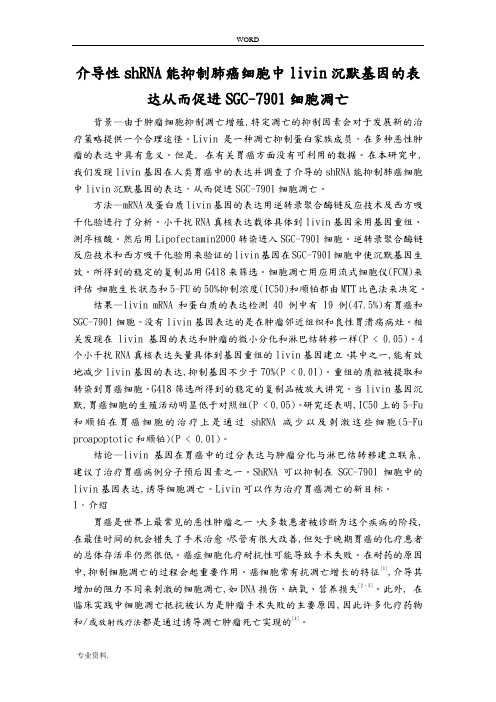
介导性shRNA能抑制肺癌细胞中livin沉默基因的表达从而促进SGC-7901细胞凋亡背景—由于肿瘤细胞抑制凋亡增殖,特定凋亡的抑制因素会对于发展新的治疗策略提供一个合理途径。
Livin是一种凋亡抑制蛋白家族成员,在多种恶性肿瘤的表达中具有意义。
但是, 在有关胃癌方面没有可利用的数据。
在本研究中,我们发现livin基因在人类胃癌中的表达并调查了介导的shRNA能抑制肺癌细胞中livin沉默基因的表达,从而促进SGC-7901细胞凋亡。
方法—mRNA及蛋白质livin基因的表达用逆转录聚合酶链反应技术及西方吸干化验进行了分析。
小干扰RNA真核表达载体具体到livin基因采用基因重组、测序核酸。
然后用Lipofectamin2000转染进入SGC-7901细胞。
逆转录聚合酶链反应技术和西方吸干化验用来验证的livin基因在SGC-7901细胞中使沉默基因生效。
所得到的稳定的复制品用G418来筛选。
细胞凋亡用应用流式细胞仪(FCM)来评估。
细胞生长状态和5-FU的50%抑制浓度(IC50)和顺铂都由MTT比色法来决定。
结果—livin mRNA和蛋白质的表达检测40例中有19例(47.5%)有胃癌和SGC-7901细胞。
没有livin基因表达的是在肿瘤邻近组织和良性胃溃疡病灶。
相关发现在livin基因的表达和肿瘤的微小分化和淋巴结转移一样(P < 0.05)。
4个小干扰RNA真核表达矢量具体到基因重组的livin基因建立。
其中之一,能有效地减少livin基因的表达,抑制基因不少于70%(P < 0.01)。
重组的质粒被提取和转染到胃癌细胞。
G418筛选所得到的稳定的复制品被放大讲究。
当livin基因沉默,胃癌细胞的生殖活动明显低于对照组(P < 0.05)。
研究还表明,IC50上的5-Fu 和顺铂在胃癌细胞的治疗上是通过shRNA减少以及刺激这些细胞(5-Fu proapoptotic和顺铂)(P < 0.01)。
各类医学中英文对照 精品
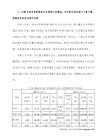
Euchromatin (常染色体):间期核内除了异染色质之外的所有基因组。
Evolutionary clock (进化钟):特定基因突变积累的速度定义。
Excision (切除):噬菌体、附加体或其它序列的切除是指它们以自主DNA分子形式从宿主染色体中释放出来。
Exonucleases (核酸外切酶):从核酸链中每次从一头切割一个核苷酸,可能特异性切割DNA或者RNA 的5¢或者3¢端。
Expression vector (表达载体):设计好的克隆载体,使编码序列插入特定的位点,能够转录和翻译成蛋白质。
Extranuclear genes (核外基因):核外的、定位在细胞器,如线粒体或叶绿体中的基因。
Enhancer (增强子):是一个顺式作用序列,能够提高一些真核生物启动子的利用,并能够在启动子任何方向以及任何位置(上游或者下游)作用。
Enelopes (包膜):某些细胞器外膜(如细胞核或线粒体),由同中心的膜构成,每一个膜由磷脂双分子层组成。
Episome change (后天改变):不影响基因型但是改变表型。它们包括细胞性质的改变,这是遗传的但是在遗传信息上没有表现出改变。
Eadie plot|Eadie图
Eadie plotting|Eadie作图法[用于酶促反应动力学]
early gene|早期基因[可特指病毒]
early hypersensitivity|早发型超敏反应
early phage|早期[有时特指病毒复制的早期]
Episome (附加体):能够整合进细菌DNA 中的质粒。
Epistasis (上位性):指一个基因的表达会模糊另一个基因的表型效果。
医学文献指标的中英文术语对照

医学文献指标的中英文术语对照引言:医学文献是医学研究和临床实践中不可或缺的重要信息来源。
在阅读和理解医学文献时,掌握准确的中英文术语对照是十分必要的。
本文将介绍一些常见的医学文献指标的中英文术语对照,帮助读者更好地理解和应用这些指标。
一、Study Design (研究设计)1. 随机对照试验 (Randomized Controlled Trial, RCT)- 定义:将研究对象随机分为实验组和对照组,对比两组结果以评估干预措施的疗效- 示例: A randomized controlled trial of drug A on patients with hypertension2. 前瞻性队列研究 (Prospective Cohort Study)- 定义:在研究开始之前,根据暴露因素进行观察,随访研究对象并记录结果- 示例: A prospective cohort study of smoking and lung cancer risk3. 横断面研究 (Cross-sectional Study)- 定义:在某个特定时间点上收集数据,不考虑因果关系- 示例: A cross-sectional study of the prevalence of diabetes in a rural community二、Outcome Measures (研究终点指标)1. 死亡率 (Mortality Rate)- 定义:在一定时间内发生死亡的患者数与特定人群总数之比- 示例: The mortality rate of patients with heart failure after one year of follow-up2. 生存率 (Survival Rate)- 定义:在一定时间内生存下来的患者数与特定人群总数之比- 示例: The 5-year survival rate of breast cancer patients receiving chemotherapy3. 病情进展率 (Progression Rate)- 定义:患者疾病进展的速度或患病程度的评估指标- 示例: The progression rate of multiple sclerosis measured by MRI scans三、Statistical Analysis (统计分析)1. 方差分析 (Analysis of Variance, ANOVA)- 定义:用于比较多个组别差异的统计方法- 示例: One-way ANOVA was used to analyze the differences in blood pressure among different age groups2. 相关分析 (Correlation Analysis)- 定义:评估两个变量之间关系的统计方法- 示例: Pearson correlation analysis was performed to examine the association between BMI and blood glucose levels3. 生存分析 (Survival Analysis)- 定义:评估患者生存时间的统计方法,常用于研究肿瘤等疾病- 示例: Kaplan-Meier survival analysis was used to assess the overall survival rates of lung cancer patients四、Evidence Levels (证据级别)1. 临床实证 (Level of Evidence)- 定义:根据研究设计和方法的科学性和可靠性评估研究证据的质量- 示例: This meta-analysis provides high-level evidence for the efficacy of drug B in treating depression2. 系统综述及Meta分析 (Systematic Review and Meta-analysis)- 定义:对多个独立研究进行整体分析和结论汇总的研究方法- 示例: A systematic review and meta-analysis of the effectiveness of acupuncture for chronic pain management3. 专家共识 (Expert Consensus)- 定义:基于专家意见和经验形成的共识性陈述- 示例: The current guidelines are based on expert consensus and clinical experience结论:通过掌握医学文献指标中的中英文术语对照,读者能够更准确地理解和应用这些指标,在医学研究和临床实践中获得准确和可靠的信息支持。
中英对照外文文献(标题)对照
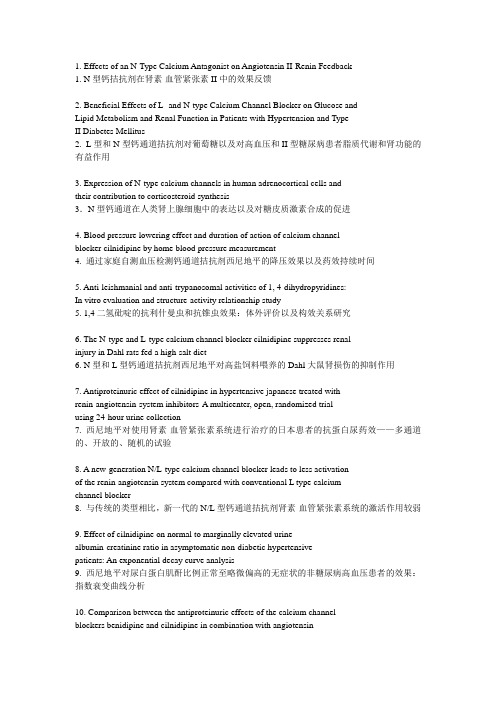
1. Effects of an N-Type Calcium Antagonist on Angiotensin II-Renin Feedback1. N型钙拮抗剂在肾素-血管紧张素II中的效果反馈2. Beneficial Effects of L- and N-type Calcium Channel Blocker on Glucose andLipid Metabolism and Renal Function in Patients with Hypertension and TypeII Diabetes Mellitus2. L型和N型钙通道拮抗剂对葡萄糖以及对高血压和II型糖尿病患者脂质代谢和肾功能的有益作用3. Expression of N-type calcium channels in human adrenocortical cells andtheir contribution to corticosteroid synthesis3.N型钙通道在人类肾上腺细胞中的表达以及对糖皮质激素合成的促进4. Blood pressure lowering effect and duration of action of calcium channelblocker cilnidipine by home blood pressure measurement4. 通过家庭自测血压检测钙通道拮抗剂西尼地平的降压效果以及药效持续时间5. Anti-leishmanial and anti-trypanosomal activities of 1, 4-dihydropyridines:In vitro evaluation and structure-activity relationship study5. 1,4二氢砒啶的抗利什曼虫和抗锥虫效果:体外评价以及构效关系研究6. The N-type and L-type calcium channel blocker cilnidipine suppresses renalinjury in Dahl rats fed a high-salt diet6. N型和L型钙通道拮抗剂西尼地平对高盐饲料喂养的Dahl大鼠肾损伤的抑制作用7. Antiproteinuric effect of cilnidipine in hypertensive japanese treated withrenin-angiotensin-system inhibitors-A multicenter, open, randomized trialusing 24-hour urine collection7. 西尼地平对使用肾素-血管紧张素系统进行治疗的日本患者的抗蛋白尿药效——多通道的、开放的、随机的试验8. A new-generation N/L-type calcium channel blocker leads to less activationof the renin-angiotensin system compared with conventional L type calciumchannel blocker8. 与传统的类型相比,新一代的N/L型钙通道拮抗剂肾素-血管紧张素系统的激活作用较弱9. Effect of cilnidipine on normal to marginally elevated urinealbumin-creatinine ratio in asymptomatic non-diabetic hypertensivepatients: An exponential decay curve analysis9. 西尼地平对尿白蛋白肌酐比例正常至略微偏高的无症状的非糖尿病高血压患者的效果:指数衰变曲线分析10. Comparison between the antiproteinuric effects of the calcium channelblockers benidipine and cilnidipine in combination with angiotensinreceptor blockers in hypertensive patients with chronic kidney disease10. 钙通道拮抗剂贝尼地平与西尼地平和血管紧张素结合的抗蛋白尿效果比较11. Cilnidipine additively inhibits the progression of renal impairment indiabetic rats when used in combination with an angiotensin II receptorblocker (ARB)11. 西尼地平在与血管紧张素II受体拮抗剂(ARB)同时使用时,可抑制糖尿病大鼠体内肾损害的发展12. T-type Ca channel blockade as a determinant of kidney protection12. T型钙通道接抗体为保护肾脏的决定因素13. Renal protection effect of cilnidipine for long term in chronic kidneydisease patients13. 西尼地平对慢性肾病患者肾脏保护作用的长效性14. The L/N-type calcium channel blocker, cilnidipine, reduces heart rate andalbuminuria in patients with type 214. L/N型钙通道拮抗剂,西尼地平,可降低2型糖尿病患者的心率15. Dual actions of cilnidipine in human internal thoracic artery: Inhibitionof calcium channels and enhancement of endothelial nitric oxide synthase15. 西尼地平对人类胸廓内动脉的双重作用:钙通道抑制和内皮型一氧化氮合成酶的提高16. Cilnidipine inhibited renal injury and reninangiotensin-aldosterone systemin deoxycorticosterone-salt hypertensive rats16. 西尼地平对去氧皮质酮醋酸盐高血压鼠的肾损伤和肾素-血管紧张素-醛固酮系统的抑制作用17. Reno-protective effect of cilnidipine in metabolic syndrome rats; possibleinvolvement of N-type calcium channel in podocyte17. 西尼地平对代谢综合症大鼠的肾脏保护作用;可能涉及足细胞中的N型钙通道18. Comparative effects of amlodipine and cilnidipine on sympathetic nervousmodulation in patients with hypertension18. 氨录地平与西尼地平对高血压患者的交感神经调节的对比效果19. Benidipine, a dihydropyridine L-type/T-type calcium channel blocker,affords additive benefits for prevention of cardiorenal injury inhypertensive rats19. 贝尼地平,一种二氢砒啶L型/T型钙通道拮抗剂,同时还可预防高血压鼠的心肾损伤20. A cross-over comparison of anti-albuminuric effects among 4 types calciumchannel blockers on chronic kidney disease20. 针对慢性肾病的四种钙通道接抗体的抗蛋白尿性交叉对比21. The effect of irbesartan on blood pressures and albuminuria in hypertensivetype 2 diabetic patients21. 厄贝沙坦对2型糖尿病合并高血压患者的降血压、控制蛋白尿的作用22. Cilnidipine suppresses podocyte injury and proteinuria in metabolicsyndrome rats: Possible involvement of N-type calcium channel in podocyte22. 西尼地平对新陈代谢症状大鼠的足细胞损伤和蛋白尿的抑制作用:可能涉及足细胞中的N型钙通道23. Bioequivalence of two cilnidipine formulations in healthy chinesevolunteers23. 在中国志愿者中俩种西尼地平配方的生物等效性24. Effect of cilnidipine vs losartan on cerebral blood flow in hypertensivepatients with a history of ischemic stroke: A randomized controlled trial24. 西尼地平与氯沙坦对有缺血性脑卒中史的高血压患者的脑血流的作用对比:随机对照试验25. Calcium antagonists: current and future applications based on new evidence.Calcium channel blockers and autonomic nervous system25. 钙拮抗剂:基于新论据而作出的现今的以及将来的应用。
医学英文翻译文献
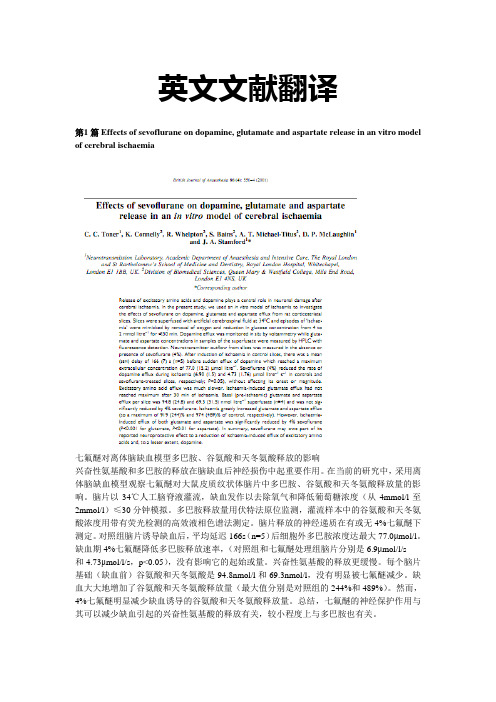
英文文献翻译第1 篇 Effects of sevoflurane on dopamine, glutamate and aspartate release in an vitro model of cerebral ischaemia七氟醚对离体脑缺血模型多巴胺、谷氨酸和天冬氨酸释放的影响兴奋性氨基酸和多巴胺的释放在脑缺血后神经损伤中起重要作用。
在当前的研究中,采用离体脑缺血模型观察七氟醚对大鼠皮质纹状体脑片中多巴胺、谷氨酸和天冬氨酸释放量的影响。
脑片以34℃人工脑脊液灌流,缺血发作以去除氧气和降低葡萄糖浓度(从4mmol/l至2mmol/l)≤30分钟模拟。
多巴胺释放量用伏特法原位监测,灌流样本中的谷氨酸和天冬氨酸浓度用带有荧光检测的高效液相色谱法测定。
脑片释放的神经递质在有或无4%七氟醚下测定。
对照组脑片诱导缺血后,平均延迟166s(n=5)后细胞外多巴胺浓度达最大77.0μmol/l。
缺血期4%七氟醚降低多巴胺释放速率,(对照组和七氟醚处理组脑片分别是6.9μmol/l/s和4.73μmol/l/s,p<0.05),没有影响它的起始或量。
兴奋性氨基酸的释放更缓慢。
每个脑片基础(缺血前)谷氨酸和天冬氨酸是94.8nmol/l和69.3nmol/l,没有明显被七氟醚减少。
缺血大大地增加了谷氨酸和天冬氨酸释放量(最大值分别是对照组的244%和489%)。
然而,4%七氟醚明显减少缺血诱导的谷氨酸和天冬氨酸释放量。
总结,七氟醚的神经保护作用与其可以减少缺血引起的兴奋性氨基酸的释放有关,较小程度上与多巴胺也有关。
第2篇The Influence of Mitochondrial K ATP-Channels in the Cardioprotection of Proconditioning and Postconditioning by Sevoflurane in the Rat In Vivo线粒体K ATP通道在离体大鼠七氟醚预处理和后处理中心肌保护作用中的影响挥发性麻醉药引起心肌预处理并也能在给予再灌注的开始保护心脏——一种实践目前被称为后处理。
病历中英文对照文献
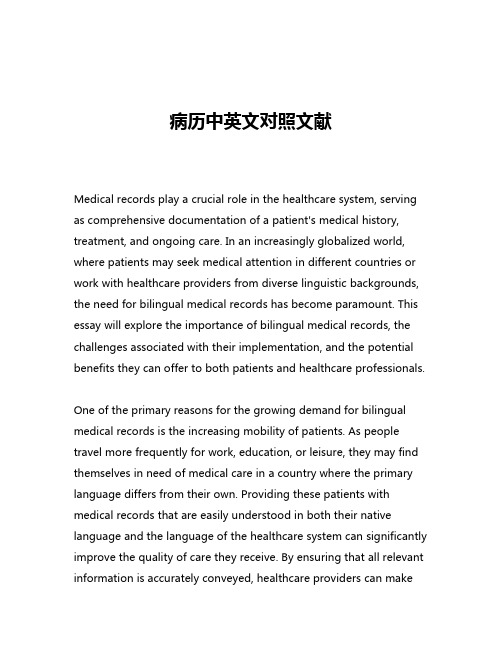
病历中英文对照文献Medical records play a crucial role in the healthcare system, serving as comprehensive documentation of a patient's medical history, treatment, and ongoing care. In an increasingly globalized world, where patients may seek medical attention in different countries or work with healthcare providers from diverse linguistic backgrounds, the need for bilingual medical records has become paramount. This essay will explore the importance of bilingual medical records, the challenges associated with their implementation, and the potential benefits they can offer to both patients and healthcare professionals.One of the primary reasons for the growing demand for bilingual medical records is the increasing mobility of patients. As people travel more frequently for work, education, or leisure, they may find themselves in need of medical care in a country where the primary language differs from their own. Providing these patients with medical records that are easily understood in both their native language and the language of the healthcare system can significantly improve the quality of care they receive. By ensuring that all relevant information is accurately conveyed, healthcare providers can makemore informed decisions, tailor treatments to the patient's specific needs, and reduce the risk of misunderstandings or medical errors.Moreover, the importance of bilingual medical records extends beyond the needs of traveling patients. In many countries, particularly those with diverse immigrant populations, healthcare providers often encounter patients who do not speak the dominant language fluently. In these situations, the availability of bilingual medical records can greatly facilitate communication and ensure that the patient's medical history, symptoms, and treatment preferences are accurately documented and understood by the healthcare team. This can lead to more effective and personalized care, as well as a more positive patient experience.The implementation of bilingual medical records, however, is not without its challenges. One of the primary obstacles is the need for accurate and consistent translation of medical terminology and documentation. Medical language can be highly specialized, with a vast array of technical terms and abbreviations that may not have direct equivalents in other languages. Ensuring the accuracy and consistency of these translations is crucial, as any discrepancies or errors could have serious implications for patient care.Another challenge lies in the standardization and integration of bilingual medical records within existing healthcare systems.Healthcare providers often rely on established electronic medical record (EMR) systems, and the integration of bilingual functionality into these systems can be a complex and resource-intensive process. Factors such as data storage, user interfaces, and data exchange protocols must all be carefully considered to ensure the seamless integration of bilingual medical records.Despite these challenges, the potential benefits of bilingual medical records are significant. By facilitating better communication and understanding between patients and healthcare providers, bilingual medical records can lead to improved health outcomes, reduced medical errors, and enhanced patient satisfaction. Patients who are able to access and understand their medical records in their native language are more likely to be actively engaged in their own healthcare, leading to better adherence to treatment plans and a stronger partnership between the patient and the healthcare team.Moreover, the availability of bilingual medical records can also have broader societal benefits. In regions with diverse immigrant populations, the provision of bilingual medical records can help to address healthcare disparities and ensure that all members of the community have equal access to quality medical care, regardless of their linguistic background. This can contribute to the overall well-being of the population and promote social equity in the healthcare system.In conclusion, the importance of bilingual medical records cannot be overstated. As the world becomes increasingly interconnected, the need for effective communication and understanding between patients and healthcare providers has become more critical than ever. By addressing the challenges associated with the implementation of bilingual medical records and embracing the potential benefits they offer, healthcare systems can strive to provide more inclusive, personalized, and effective care for all patients, regardless of their linguistic background. This commitment to bilingual medical records represents a crucial step towards a more equitable and accessible healthcare system, one that can truly meet the diverse needs of the global community.。
医学文献英文翻译

医学文献英文翻译原文:皮质下缺血性脑血管疾病(subcortical ischemic vasculardisease,SIVD)是一组以小血管病变为主要病因、以皮质下多发性腔隙性梗死和脑白质病变为主要脑部损害的缺血性脑血管病,是引起血管性认知功能损害(vascular cognitive impairment,VCI)最常见的亚型。
SIVD可引起步态障碍,如帕金森样步态、共济失调性步态、走路不稳或无明显诱因的频繁跌倒,有研究表明,步态异常可能是血管性痴呆的早期标志。
本文将从SIVD导致步态障碍的病理机制、步态障碍类型、步态障碍与认知损害关系、步态障碍的分析与评价、治疗等方面进行综述。
翻译:皮质下缺血性脑血管疾病(subcortical ischemic vascular disease,SIVD)是一组以小血管病变为主要病因、以皮质下多发性腔隙性梗死和脑白质病变为主要脑部损害的缺血性脑血管病,是引起血管性认知功能损害(vascular cognitive impairment,VCI)最常见的亚型。
Subcortical ischemic vascular disease(SIVD)is a case of ischemic cerebrovascular disease, the leading cause of which is small vessel lesions, and the subsequent main damages to the brain are subcortical multiple lacunae infarct and leukodystrophy; it is the most common subtype that causes vascular cognitive impairment (VCI).SIVD可引起步态障碍,如帕金森样步态、共济失调性步态、走路不稳或无明显诱因的频繁跌倒,有研究表明,步态异常可能是血管性痴呆的早期标志。
医学常用病症中英文对照与翻译
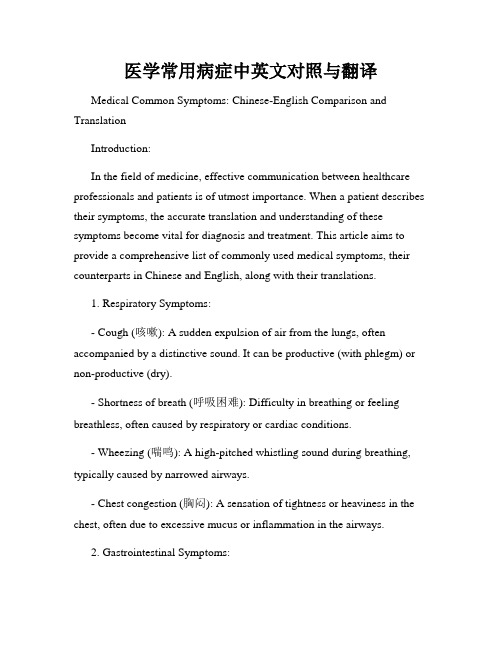
医学常用病症中英文对照与翻译Medical Common Symptoms: Chinese-English Comparison and TranslationIntroduction:In the field of medicine, effective communication between healthcare professionals and patients is of utmost importance. When a patient describes their symptoms, the accurate translation and understanding of these symptoms become vital for diagnosis and treatment. This article aims to provide a comprehensive list of commonly used medical symptoms, their counterparts in Chinese and English, along with their translations.1. Respiratory Symptoms:- Cough (咳嗽): A sudden expulsion of air from the lungs, often accompanied by a distinctive sound. It can be productive (with phlegm) or non-productive (dry).- Shortness of breath (呼吸困难): Difficulty in breathing or feeling breathless, often caused by respiratory or cardiac conditions.- Wheezing (喘鸣): A high-pitched whistling sound during breathing, typically caused by narrowed airways.- Chest congestion (胸闷): A sensation of tightness or heaviness in the chest, often due to excessive mucus or inflammation in the airways.2. Gastrointestinal Symptoms:- Abdominal pain (腹痛): Pain or discomfort felt in the abdomen, which can range from mild to severe.- Nausea (恶心): A feeling of queasiness or the urge to vomit.- Vomiting (呕吐): The forceful expulsion of stomach contents through the mouth.- Diarrhea (腹泻): Frequent, loose or watery stools, often accompanied by an increased urgency to defecate.3. Neurological Symptoms:- Headache (头痛): A pain or discomfort in the head or neck region, varying in intensity and location.- Dizziness (头晕): A sensation of lightheadedness or imbalance, often described as feeling faint or unsteady.- Numbness (麻木感): A loss of sensation or reduced feeling in a particular part of the body.- Seizure (癫痫发作): A sudden, uncontrolled electrical disturbance in the brain, leading to abnormal behavior or movements.4. Musculoskeletal Symptoms:- Joint pain (关节痛): Pain, stiffness, or inflammation in one or more joints.- Muscle cramps (肌肉痉挛): Involuntary contraction or spasm of muscles.- Back pain (背痛): Pain or discomfort in the back, which can be localized or radiate to other areas.- Limited range of motion (活动受限): Difficulty or inability to move a joint or body part through its full range of motion.5. Dermatological Symptoms:- Rash (皮疹): A change in the skin's color, appearance, or texture, often accompanied by itching or discomfort.- Itching (瘙痒): An unpleasant sensation that triggers the desire to scratch the skin.- Hives (荨麻疹): Itchy, raised, and often reddened areas on the skin that appear as an allergic reaction.- Dry skin (干燥皮肤): A lack of moisture in the skin, resulting in roughness or flaking.Conclusion:Clear and accurate communication between healthcare professionals and patients is essential for proper diagnosis and treatment of medical conditions. By providing a list of commonly used medical symptoms, their Chinese and English counterparts, and translations, this article aims to facilitate effective communication in the field of medicine. Understanding and being able to convey symptoms precisely will ultimately lead to improved patient care and outcomes.。
中英文对照
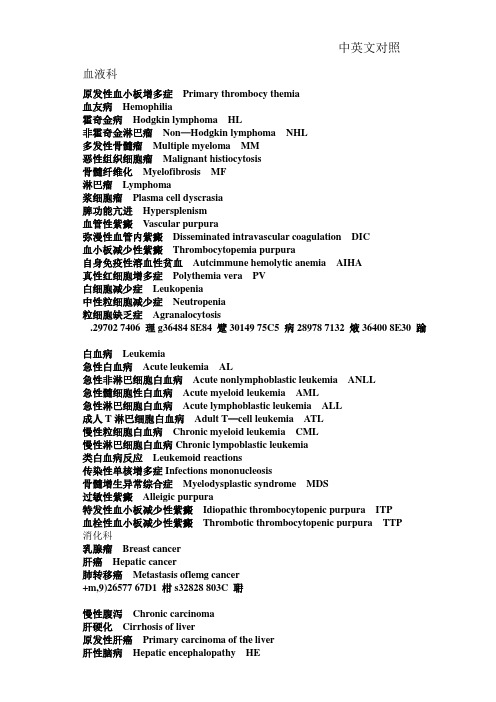
中英文对照血液科原发性血小板增多症Primary thrombocy themia血友病Hemophilia霍奇金病Hodgkin lymphoma HL非霍奇金淋巴瘤Non—Hodgkin lymphoma NHL多发性骨髓瘤Multiple myeloma MM恶性组织细胞瘤Malignant histiocytosis骨髓纤维化Myelofibrosis MF淋巴瘤Lymphoma浆细胞瘤Plasma cell dyscrasia脾功能亢进Hypersplenism血管性紫癜Vascular purpura弥漫性血管内紫癜Disseminated intravascular coagulation DIC血小板减少性紫癜Thrombocytopemia purpura自身免疫性溶血性贫血Autcimmune hemolytic anemia AIHA真性红细胞增多症Polythemia vera PV白细胞减少症Leukopenia中性粒细胞减少症Neutropenia粒细胞缺乏症Agranalocytosis.29702 7406 理g36484 8E84 躄30149 75C5 病28978 7132 焲36400 8E30 踰白血病Leukemia急性白血病Acute leukemia AL急性非淋巴细胞白血病Acute nonlymphoblastic leukemia ANLL急性髓细胞性白血病Acute myeloid leukemia AML急性淋巴细胞白血病Acute lymphoblastic leukemia ALL成人T淋巴细胞白血病Adult T—cell leukemia ATL慢性粒细胞白血病Chronic myeloid leukemia CML慢性淋巴细胞白血病Chronic lympoblastic leukemia类白血病反应Leukemoid reactions传染性单核增多症Infections mononucleosis骨髓增生异常综合症Myelodysplastic syndrome MDS过敏性紫癜Alleigic purpura特发性血小板减少性紫癜Idiopathic thrombocytopenic purpura ITP血栓性血小板减少性紫癜Thrombotic thrombocytopenic purpura TTP消化科乳腺瘤Breast cancer肝癌Hepatic cancer肺转移癌Metastasis oflemg cancer+m,9)26577 67D1 柑s32828 803C 耼慢性腹泻Chronic carcinoma肝硬化Cirrhosis of liver原发性肝癌Primary carcinoma of the liver肝性脑病Hepatic encephalopathy HE急性胰腺炎Acute pancreatitis慢性胰腺炎Chronic pancreatitis胰腺癌Carcinoma of pancreas结合性腹膜炎Tuberculous peritonitis上消化道出血upper gastrointestinal hemorrhage贫血Anemia缺铁性贫血Iron deficient巨幼细胞性贫血Megaloblastic anemia再生障碍性贫血Aplastic anemia AA恶性贫血Pernicious anemia慢性病贫血Anemia of chronic disease急性再生障碍性贫血Acute aplastic anemia纯红细胞再生障碍Purered cell aplasia anemia阵发性睡眠性血红蛋白尿症Parexysmall nocturmal hemoglobinuria PNH \24791 60D7 惗38717 973D 霽j`21834 554A 啊29256 7248 版胃食管反流病Gestroesophageal reflux disease gerd食管癌Carcinoma of the esophagus胃炎fastritis急性胃炎acute gastritis急性糜烂出血性肾炎Acute erosire and hemorrhagic gasteitis萎缩性胃炎airophic gastritis消化性溃疡peptic ulcer胃溃疡gastric ulcer GU十二指肠溃疡duodenal ulcer DU胃癌gastric cancer胃腺癌gastric adenocercinoma肺结核intestinal tuberulosisCrohn病crohns disease炎症性肠炎疡inflammatory bowet disease IBD溃疡性结肠炎ulcerative colitis大肠癌结肠癌carcinoma of the colon and rectun功能性胃肠癌functional dyspepsia FD肠易激综合症irrigatable bowel syndrome21219 52E3 勣=35145 8949 襉40334 9D8E 鶎UK肠结核intestinal tuberculosis未定型结肠炎indeterminate cvlitis功能性便秘functional constipation慢性乙性肝炎chronic hepatitis B virus hepatitis慢性丙性肝炎chronic hepatitis C virus hepatitis急性胆囊炎acute cholecysititis急性胰腺炎acute pancreutitis慢性阑尾炎chromic cholecysitis慢性胰腺炎chromic pancreutitis肠梗阻intestinal obstruction腹股沟斜疝direat ingwinal hernia脾破裂splenic mpture甲状腺腺瘤thyroid adenoma甲状腺瘤thyroid carcinoma原发性腹膜炎primary peritonitits乳腺瘤mammary cancer原发性肝癌primary carcinoma of the liver胰腺癌carcinama of pancreaseQ38548 9694 隔n~22196 56B4 嚴n35591 8B07 謇u胆囊癌gaubladder cancer肝包虫hepatic hydatidosis下肢静脉曲张varicose veins of lower extremity结直肠癌carcinoma of colon and reaturn肛瘘anal fistula胆石症cholelithiasis肛门癌anal cancer胃肠间质癌gastrointestinal stromal tumors宫颈癌cervical cancer卵巢癌ovarian cancer子宫内膜癌endometrial cancer子宫肉瘤aterine sarcomas绒毛膜上皮瘤choriocarcinoma小细胞肺癌small cell lury cancer非小细胞肺癌non small cell luny cancer黑色素瘤melanoma肉瘤sarcomas膀胱癌bladder cancerx!40418 9DE2 鷢28001 6D61 浡26299 66BB 暻24344 5F18 弘1肾癌renal cell cancer垂体瘤pituitary adenoma直肠癌colorectal carcinoma鼻咽癌nasopharyngeal carcinama肠血管畸形vascular malformation VM淋巴结转移癌cervical metastatic cancer胃溃疡并出血gastric ulcer and blood十二指肠溃疡duodenal ulcer DU胃息肉gastric sarcoma原发性血小板增多症Primary thrombocy themia血友病Hemophilia 冠状动脉粥样硬化性心脏病coronary atheroscle-rotic heart disease 白血病leukemia 嗳气eructation霍奇金病Hodgkin lymphoma HL非霍奇金淋巴瘤Non-Hodgkin lymphoma NHL多发性骨髓瘤Multiple myeloma MM 恶性组织细胞瘤Malignant histiocytosis骨髓纤维化Myelofibrosis MF淋巴瘤Lymphoma浆细胞瘤Plasma cell dyscrasia脾功能亢进Hypersplenism血管性紫癜Vascular purpura弥漫性血管内紫癜Disseminated intravascular coagulation DIC血小板减少性紫癜Thrombocytopemia purpura 自身免疫性溶血性贫血Autcimmune hemolytic anemia AIHA真性红细胞增多症Polythemia vera PV白细胞减少症Leukopenia中性粒细胞减少症Neutropenia粒细胞缺乏症Agranalocytosis白血病Leukemia急性白血病Acute leukemia AL急性非淋巴细胞白血病Acute nonlymphoblastic leukemia ANLL急性髓细胞性白血病Acute myeloid leukemia AML急性淋巴细胞白血病Acute lymphoblastic leukemia ALL 缺铁性红细胞生成iron deficient erythropoiesis成人T淋巴细胞白血病Adult T-cell leukemia ATL慢性粒细胞白血病Chronic myeloid leukemia CML慢性淋巴细胞白血病Chronic lympoblastic leukemia类白血病反应Leukemoid reactions传染性单核增多症Infections mononucleosis骨髓增生异常综合症Myelodysplastic syndrome MDS过敏性紫癜Alleigic purpura特发性血小板减少性紫癜Idiopathic thrombocytopenic purpura ITP血栓性血小板减少性紫癜Thrombotic thrombocytopenic purpura TTP 肠结核intestinal tuberculosis乳腺瘤Breast cancer肝癌Hepatic cancer肺转移癌Metastasis oflemg cancer慢性腹泻Chronic carcinoma肝硬化Cirrhosis of liver原发性肝癌Primary carcinoma of the liver肝性脑病Hepatic encephalopathy HE急性胰腺炎Acute pancreatitis慢性胰腺炎Chronic pancreatitis 胰腺癌Carcinoma of pancreas 帕金森病Parkinson's disease 皮肌炎dermatomyositis结合性腹膜炎Tuberculous peritonitis上消化道出血upper gastrointestinal hemorrhage贫血Anemia缺铁性贫血Iron deficient巨幼细胞性贫血Megaloblastic anemia再生障碍性贫血Aplastic anemia AA恶性贫血Pernicious anemia慢性病贫血Anemia of chronic disease急性再生障碍性贫血Acute aplastic anemia纯红细胞再生障碍Purered cell aplasia anemia 急性糜烂性出血性胃炎actue erosive-hemorrhagic gastritis阵发性睡眠性血红蛋白尿症Parexysmall nocturmal hemoglobinuria PNH胃食管反流病Gestroesophageal reflux disease gerd食管癌Carcinoma of the esophagus胃炎fastritis急性胃炎acute gastritis急性糜烂出血性肾炎Acute erosire and hemorrhagic gasteitis 萎缩性胃炎airophic gastritis消化性溃疡peptic ulcer胃溃疡gastric ulcer GU十二指肠溃疡duodenal ulcer DU胃癌gastric cancer胃腺癌gastric adenocercinoma肺结核intestinal tuberulosis Crohn病crohns disease炎症性肠炎疡inflammatory bowet disease IBD溃疡性结肠炎ulcerative colitis大肠癌结肠癌carcinoma of the colon and rectun功能性胃肠癌functional dyspepsia FD肠易激综合症irrigatable bowel syndrome肠结核intestinal tuberculosis未定型结肠炎indeterminate cvlitis 胃炎gastritis 稳定性心绞痛stable angina pectoris 系统性红斑狼疮systemic lupus erythematosus 心肌病cardiomyopathy 心肌梗死myocardial infarction 心力衰竭heart failure 心律失常cardiac dysrhythmia 水肿edema功能性便秘functional constipation慢性乙性肝炎chronic hepatitis B virus hepatitis慢性丙性肝炎chronic hepatitis C virus hepatitis急性胆囊炎acute cholecysititis急性胰腺炎acute pancreutitis慢性阑尾炎chromic cholecysitis慢性胰腺炎chromic pancreutitis肠梗阻intestinal obstruction腹股沟斜疝direat ingwinal hernia脾破裂splenic mpture甲状腺腺瘤thyroid adenoma甲状腺瘤thyroid carcinoma原发性腹膜炎primary peritonitits乳腺瘤mammary cancer原发性肝癌primary carcinoma of the liver胰腺癌carcinama of pancrease 胆囊癌gaubladder cancer肝包虫hepatic hydatidosis下肢静脉曲张varicose veins of lower extremity 结直肠癌carcinoma of colon and reaturn肛瘘anal fistula胆石症cholelithiasis肛门癌anal cancer胃肠间质癌gastrointestinal stromal tumors宫颈癌cervical cancer卵巢癌ovarian cancer子宫内膜癌endometrial cancer子宫肉瘤aterine sarcomas绒毛膜上皮瘤choriocarcinoma小细胞肺癌small cell lury cancer非小细胞肺癌non small cell luny cancer黑色素瘤melanoma肉瘤sarcomas膀胱癌bladder cancer肾癌renal cell cancer垂体瘤pituitary adenoma直肠癌colorectal carcinoma鼻咽癌nasopharyngeal carcinama肠血管畸形vascularmalformation VM淋巴结转移癌cervical metastatic cancer胃溃疡并出血gastric ulcer and blood十二指肠溃疡duodenal ulcer DU胃息肉gastric sarcoma 骨髓瘤myeloma 阵发性室上心动过速paroxysmal supraventricu—lar tachycardia 原发性支气管肺癌primary bronchogenic carcino-ma 原发性高血压primary hypertension 预激综合征preexcitation syndrome 支气管扩张bronchiectasis 支气管哮喘bronchial asthma 隐匿性肾小球肾炎latent glomerulonephritis 心室间隔缺损ventricular septal defect 深静脉血栓形成deep venous thrombosis 急性支气管炎acute tracheo—bronchitis 急性上呼吸道感染acute upper respiratory tractinfection 急性肾衰竭acute renal failure 急性肾小管坏死acute tubular necrosis 甲状腺功能减退症hypothyroidism 甲状腺功能亢进症hyperthyroidism 经皮冠状动脉介入治疗PCI 经皮冠状动脉腔内成形术PTCA 克罗恩病Crohn’s disease 溃疡性结肠炎ulcerative colitis 类风湿关节炎rheumatoid arthritis 慢性肺源性心脏病chronic pulmonary heart dis-ease 脑栓塞cerebral embolism 癫痫epilepsy 多发性肌炎polymyositis 肥厚性心肌病hypertrophic cardiomyopathy 肺梗死pulmonary infarction 肺栓塞pulmonary embolism 风湿性心脏瓣膜病rhematic valvular heart dis –dase 腹膜透析peritoneal dialysis 腹腔穿刺术abdominocentesis 腹水ascites 腹痛abdominal pain 腹泻diarrhea 腹胀abdominal distension 肝肺综合征hepatopulmonary syndrome 肝肾综合征hepatotenal syndrome 肝纤维化hepatic fibrosis 肝性昏迷hepatic coma 肝性脑病hepatic encephalopathy 肝性胸水hepatic hydrothorax 骨质疏松osteoporosis 冠状动脉性心脏病coronary heart disease 冠状动脉造影术CAG 黑便melena 呼吸衰竭respiratory failure 病毒性肺炎viral pneumonia 病毒性肝炎viral hepatitis 病毒性心肌炎viral myocarditis 病态窦房结综合征sick sinus syndrome 主动脉关闭不全aortic incompetence 主动脉瓣狭窄aortic stenosis 心悸palpitation 心室颤动ventricular fibrillation 心房颤动atrial fibrillation 细菌性食物中毒bacterial food poisoning 细菌性痢疾bacillary dysentery 血友病hemophilia 心室扑动ventricular flutter 心源性呼吸困难cardiogenic dyspnea 心源性晕厥cardiogenic syncope 心脏瓣膜病valvular heart disease 应激相关胃黏膜损伤stress-related gastric muco-sal injury 贫血anemia 糖尿病diabetes mellitus 糖尿病酮症酸中毒diabetic ketoacidosis 痛风gout 头痛headache。
医学中英文对照文章

医学中英文对照文章随着信息化社会的高速发展,国民的健康意识不断提高,我国借鉴发达国家先进的健康管理经验,初步形成了具有一定中国国情的健康管理模式,国民参与健康管理的意识大大增强。
下面是小编带来的医学中英文对照文章,欢迎阅读!医学中英文对照文章1美国科学家研究起死回生术A groundbreaking trial to see if it is possible to regenerate the brains of dead people, has won approval from health watchdogs.探究死者大脑能否重获新生的开创性实验已获卫生监管部门批准可以开展。
A biotech company in the US has been granted ethical permission to recruit 20 patients who have been declared clinically dead from a traumatic brain injury, to test whether parts of their central nervous system can be brought back to life.美国一家生物科技公司获得伦理许可,将招募20位因脑创伤被宣布临床死亡的病人,用于测试他们的部分中枢神经系统能否被复苏。
Scientists will use a combination of therapies, whichinclude injecting the brain with stem cells and a cocktail of peptides, as well as deploying lasers and nerve stimulation techniques which have been shown to bring patients out of comas.科学家们将合用多种治疗方法,包括给大脑注入干细胞和混合多肽,以及利用激光和神经刺激技术等等。
医学文献中英文对照
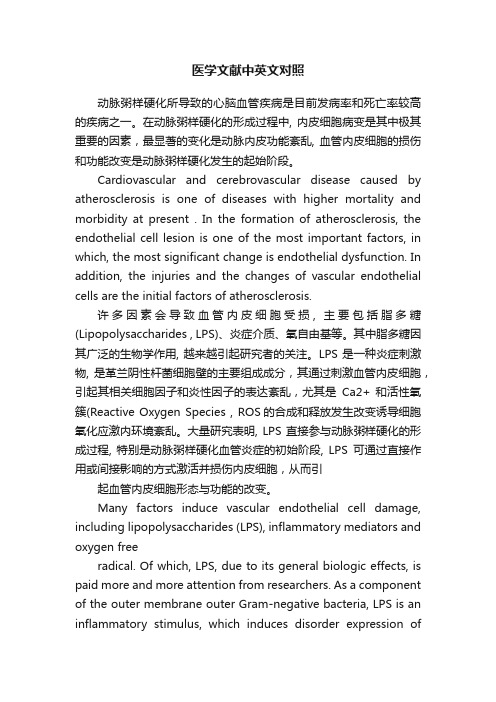
医学文献中英文对照动脉粥样硬化所导致的心脑血管疾病是目前发病率和死亡率较高的疾病之一。
在动脉粥样硬化的形成过程中, 内皮细胞病变是其中极其重要的因素,最显著的变化是动脉内皮功能紊乱, 血管内皮细胞的损伤和功能改变是动脉粥样硬化发生的起始阶段。
Cardiovascular and cerebrovascular disease caused by atherosclerosis is one of diseases with higher mortality and morbidity at present . In the formation of atherosclerosis, the endothelial cell lesion is one of the most important factors, in which, the most significant change is endothelial dysfunction. In addition, the injuries and the changes of vascular endothelial cells are the initial factors of atherosclerosis.许多因素会导致血管内皮细胞受损, 主要包括脂多糖(Lipopolysaccharides , LPS)、炎症介质、氧自由基等。
其中脂多糖因其广泛的生物学作用, 越来越引起研究者的关注。
LPS 是一种炎症刺激物, 是革兰阴性杆菌细胞壁的主要组成成分,其通过刺激血管内皮细胞,引起其相关细胞因子和炎性因子的表达紊乱,尤其是Ca2+ 和活性氧簇(Reactive Oxygen Species , ROS的合成和释放发生改变诱导细胞氧化应激内环境紊乱。
大量研究表明, LPS 直接参与动脉粥样硬化的形成过程, 特别是动脉粥样硬化血管炎症的初始阶段, LPS可通过直接作用或间接影响的方式激活并损伤内皮细胞,从而引起血管内皮细胞形态与功能的改变。
医学文献翻译(中英对照)
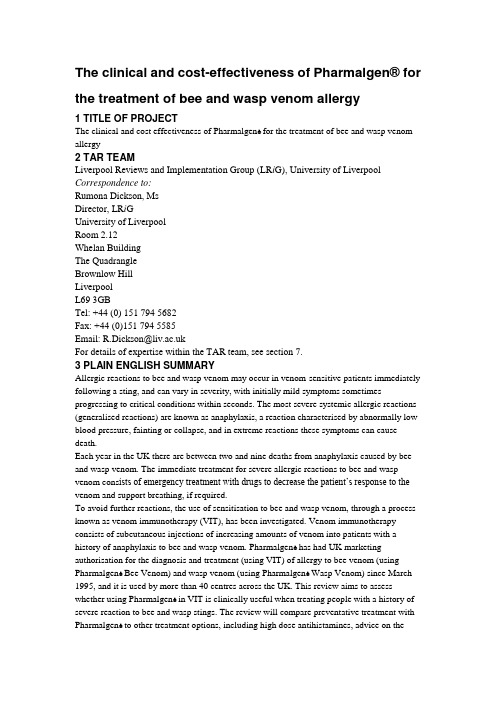
The clinical and cost-effectiveness of Pharmalgen® for the treatment of bee and wasp venom allergy1 TITLE OF PROJECTThe clinical and cost effectiveness of Pharmalgen® for the treatment of bee and wasp venom allergy2 TAR TEAMLiverpool Reviews and Implementation Group (LR i G), University of Liverpool Correspondence to:Rumona Dickson, MsDirector, LR i GUniversity of LiverpoolRoom 2.12Whelan BuildingThe QuadrangleBrownlow HillLiverpoolL69 3GBTel: +44 (0) 151 794 5682Fax: +44 (0)151 794 5585Email:****************.ukFor details of expertise within the TAR team, see section 7.3 PLAIN ENGLISH SUMMARYAllergic reactions to bee and wasp venom may occur in venom-sensitive patients immediately following a sting, and can vary in severity, with initially mild symptoms sometimes progressing to critical conditions within seconds. The most severe systemic allergic reactions (generalised reactions) are known as anaphylaxis, a reaction characterised by abnormally low blood pressure, fainting or collapse, and in extreme reactions these symptoms can cause death.Each year in the UK there are between two and nine deaths from anaphylaxis caused by bee and wasp venom. The immediate treatment for severe allergic reactions to bee and wasp venom cons ists of emergency treatment with drugs to decrease the patient’s response to the venom and support breathing, if required.To avoid further reactions, the use of sensitisation to bee and wasp venom, through a process known as venom immunotherapy (VIT), has been investigated. Venom immunotherapy consists of subcutaneous injections of increasing amounts of venom into patients with a history of anaphylaxis to bee and wasp venom. Pharmalgen® has had UK marketing authorisation for the diagnosis and treatment (using VIT) of allergy to bee venom (using Pharmalgen® Bee Venom) and wasp venom (using Pharmalgen® Wasp Venom) since March 1995, and it is used by more than 40 centres across the UK. This review aims to assess whether using Pharmalgen® in VIT is clinically useful when treating people with a history of severe reaction to bee and wasp stings. The review will compare preventative treatment with Pharmalgen® to other treatment options, including high dose antihistamines, advice on theavoidance of bee and wasp stings and adrenaline auto-injector prescription and training. If suitable data are available, the review will also consider the cost effectiveness of using Pharmalgen® for VIT and other subgroups including children and people at high risk of future stings or severe allergic reactions to future stings.4 DECISION PROBLEM4.1 Clarification of research question and scopePharmalgen® is used for the diagnosis and treatment of immunoglobin E (IgE)-mediated allergy to bee and wasp venom. The aim of this report is to assess whether the use of Pharmalgen® is of clinical value when providing VIT to individuals with a history of severe reaction to bee and wasp venom and whether doing so would be considered cost effective compared with alternative treatment options available in the NHS.4.2 BackgroundBees and wasps form part of the order Hymenoptera (which also includes ants), and within this order the species that cause the most frequent allergic reactions are the Vespidae (wasps, yellow jackets and hornets), and the Apinae (honeybees).1Bee and wasp stings contain allergenic proteins. In wasps, these are predominantly phospholipase A1,2 hyaluronidase2 and antigen 5,3 and in bees are phospholipase A2 and hyaluronidase.4 Following an initial sting, a type 1 hypersensitivity reaction may occur in some individuals which produces the IgE antibody. This sensitises cells to the allergen, and any subsequent exposure to the allergen may cause the allergen to bind to the IgE molecules, which results in an allergic reaction.These allergens typically produce an intense, burning pain followed by erythema (redness) and a small area of oedema (swelling) at the site of the sting. The symptoms produced following a sting can be classified into non-allergic reactions, such as local reactions, and allergic reactions, such as extensive local reactions, anaphylactic systemic reactions and delayed systemic reactions.5-6 Systemic allergic reactions may occur in venom-sensitive patients immediately following a sting,7 and can vary in severity, with initially mild symptoms sometimes progressing to critical conditions within seconds.1The most severe systemic allergic reaction is known as anaphylaxis. Anaphylactic reactions are of rapid onset (typically up to 15 minutes post sting) and can manifest in different ways. Initial symptoms are usually cutaneous followed by hypotension, with light-headedness, fainting or collapse. Some people develop respiratory symptoms due to an asthma-like response or laryngeal oedema. In severe reactions, hypotension, circulatory disturbances, and breathing difficulty can progress to fatal cardio-respiratory arrest.Anaphylaxis occurs more commonly in males and in people under 20 years of age and can be severe and potentially fatal.84.3 EpidemiologyIt is estimated that the prevalence of wasp and bee sting allergy is between 0.4% and 3.3%.9 The incidence of systemic reactions to wasp and bee venom is not reliably known, but estimates range from 0.15-3.3%,10-11 Systemic allergic reactions are reported by up to 3% of adults, and almost 1% of children have a medical history of severe sting reactions.9, 12 After a large local reaction, 5–15% of people will go on to develop a systemic reaction when next stung.13 In people with a mild systemic reaction, the risk of subsequent systemic reactions is thought to be about 18%.13 Hymenoptera venom are one of the three main causes of fatalanaphylaxis in the USA and UK.14-15 Insect stings are the second most frequent cause of anaphylaxis outside of medical settings.16 Between two and nine people in the UK die each year as a result of anaphylaxis due to reactions to wasp and bee stings.17 Once an individual has experienced an anaphylactic reaction, the risk of having a recurrent episode has been estimated to be between 60% and 79%.13In 2000, the register of fatal anaphylactic reactions in the UK from 1992 onwards was reported by Pumphrey to determine the frequency at which classic manifestations of fatal anaphylaxis are present.18 Of the 56 post-mortems carried out, 19 deaths were recorded as reactions to Hymenoptera venom (33.9%). A retrospective study in 2004 examined all deaths from anaphylaxis in the UK between 1992 and 2001, and estimated 22.19% to be reactions to Hymenoptera venom (47/212). This further breaks down into 29/212 (13.68%) as reactions to wasp stings, and 4/212 (1.89%) as reactions to bee stings. The remaining 14/212 were unidentified Hymenoptera stings (6.62%).194.4 Current diagnostic optionsCurrently, individuals can be tested to determine if they are at risk of systemic reactions to bee and wasp venom. The primary diagnostic method for systemic reactions to bee and/or wasp stings is venom skin testing.Skin testing involves intradermal injection with the five Hymenoptera venom protein extracts, with v enom concentrations in the range of 0.001 to 1.0 μg/ml. This establishes the minimum concentration giving a positive result (a reaction occurring in the individual). As venom tests show unexplained variability over time,20 and as negative skin tests can occur following recent anaphylaxis, it is recommended that tests be repeated after 1 to 6 months.21Other methods of diagnosis in patients following an anaphylactic reaction include radioallergosorbent test (RAST), which detects allergen-specific IgE antibodies in serum. This test is less sensitive than skin testing but is useful when skin tests cannot be done, for example in patients with skin conditions.22-234.5 Current treatment optionsPreventative treatments include education on how to avoid bee and wasp venom, and prescription of high dose antihistamines. Patients with a history of moderate local reactions should be provided with an emergency kit,24 containing a H1-blocking antihistamine and a topical corticosteroid for immediate use following a sting. Patients with a history of anaphylaxis should be provided with an emergency kit containing a rapid-acting H1-blocking antihistamine, an oral corticosteroid and an auto-injector for self administration, containing epinephrine.Injected epinephrine (a sympathomimetic drug which acts on both alpha and beta receptors) is regarded as the emergency treatment of choice for cases of acute anaphylaxis as a result of Hymenoptera stings.25 For adults, the recommended dose is between 0.30 mg/ml and 0.50mg/ml I.M, and 0.01 ml/kg I.M. for children. Individuals with a history of anaphylactic reactions are recommended to carry auto injectors containing epinephrine (commonly known as EpiPen®, Adrenaclick®, Anapen® or Twinject®). These are intended for immediateself-administration by individuals with a history of hypersensitivity to Hymenoptera stings and other allergens.Preventive measures following successful treatment of a systemic allergic reaction to Hymenoptera venom consists of either allergen avoidance or specific allergen immunotherapy,known as VIT. Venom immunotherapy is considered to be a safe and effective treatment.26 Currently, VIT can be used with several regimes, including Pharmalgen® (manufactured by ALK Abello, and licensed in the UK), Aquagen® and Alutard SQ® (both manufactured by ALK Abello and unlicensed in the UK but licensed in some parts of Europe), VENOMENHAL® (HAL Allergy, Leiden, Netherlands, unlicensed in the UK), Alyostal® (Stallergenes, Antony Cedex, France, unlicensed in the UK), and Venomil® (Hollister-Stier Laboratories LLC, unlicensed in the UK). Venom immunotherapy is recommended to prevent future systemic reactions. It is recommended that VIT is considered ‘when positive test results for specific IgE antibodies correlate with suspected triggers and patient exposure’.27 Venom immunotherapy consists of subcutaneous injections of increasing amounts of venom, and treatment is divided into two periods: the build up phase and maintenance phase. Venom immunotherapy is now the standard therapy for Hymenoptera sting allergy,28 and is a model for allergen-specific therapy,29-30 with success rates (patients who will remain anaphylaxis free) being reported as more than 98% in some studies.4, 31 There are now 44 centres across the UK which provide VIT to people for bee and wasp sting allergy. Venom immunotherapy is normally discontinued after 3 to 5 years, but modifications may be necessary when treating people with intense allergen exposure (such as beekeepers) or those with individual risk factors for severe reactions. There is no method of assessing which patients will be at risk of further anaphylactic reactions following administration of VIT and those who will remain anaphylaxis free in the long term following VIT.27Local or systemic adverse reactions may occur as a result of VIT. They normally develop within 30 minutes of the injection. Each patient is monitored closely following each injection to check for adverse reactions. Progression to an increased dose only occurs if the previous dose is fully tolerated.4.6 The technologyPharmalgen® is produced by ALK Abello, and has had UK marketing authorisation for the diagnosis (using skin testing/intracutaneous testing) and treatment (using VIT) ofIgE-mediated allergy to bee venom (Pharmalgen® Bee Venom) and wasp venom (Pharmalgen® Wasp Venom) since March 1995 (marketing authorisation number PL10085/0004). The active ingredient is partially purified freeze dried Vespula spp. venom in Pharmalgen® Wasp Venom and freeze dried Apis mellifera venom in Pharmalgen® Bee Venom, each provided in powder form for solution for injection.Before treatment is considered, allergy to bee or wasp venom must be confirmed by case history and diagnosis. Treatment with Pharmalgen® Bee or Wasp Venom is performed by subcutaneous injections. The treatment is carried out in two phases: the initial phase and the maintenance phase.In the build up phase, the dose is increased stepwise until the maintenance dose (the maximum tolerable dose before an allergic reaction) is achieved. ALK Abello recommends the following dosage proposals: conventional, modified rush (clustered) and rush updosing. In conventional updosing, the patient receives one injection every 3-7 days. In modified rush (clustered) updosing, the patient receives 2-4 injections once a week. If necessary this interval may be extended up to two weeks. The 2-4 injections are given with an interval of 30 minutes. In rush updosing, while being hospitalised the patient receives injections with a 2-hour interval. A maximum of four injections per day may be given in the initial phase.The build up phase ends when the individual maintenance dose has been attained and the interval between the injections is increased to 2, 3 and 4 weeks. This is called the maintenance phase, and the maintenance dose is then given every 4 weeks for at least 3 years. Contra-indications to VIT treatment are immunological diseases (e. g. immune complex diseases and immune deficiencies); chronic heart/lung diseases; treatment with β-blockers; severe eczema. Side effects include superficial wheal and flare due to shallow injection; local swelling (which may be immediate or delayed up to 48 hours); mild general reactions such as urticaria, erythema, rhinitis or mild asthma; moderate or severe general reactions such as more severe asthma, angioedema or an anaphylactic reaction with hypotension and respiratory embarrassment; anaphylaxis (often starting with erythema and pruritus, followed by urticaria, angioedema, nasal or pharyngial congestion, wheezing, dyspnoea, nausea, hypotension, syncope, tachycardia or diarrhoea). 324.7 Objectives of the HTA projectThe aim of this review is to assess the clinical and cost effectiveness of Pharmalgen® in providing immunotherapy to individuals with a history of type 1 IgE-mediated systemic allergic reaction to bee and wasp venom. The review will consider the effectiveness of Pharmalgen® when compared to alternative treatment options available in the NHS, including advice on the avoidance of bee and wasp stings, high dose antihistamines and adrenaline auto-injector prescription and training. The review will also examine the existing health economic evidence and identify the key economic issues related to the use of Pharmalgen® in UK clinical practice. If suitable data are available, an economic model will be developed and populated to evaluate if the use of Pharmalgen® for the treatment of bee and wasp venom allergy, within its licensed indication, would be a cost effective use of NHS resources.5 METHODS FOR SYNTHESISING CLINICAL EFFECTIVENESS EVIDENCE5.1 Search strategyThe major electronic databases including Medline, Embase and The Cochrane Library will be searched for relevant published literature. Information on studies in progress, unpublished research or research reported in the grey literature will be sought by searching a range of relevant databases including National Research Register and Controlled Clinical Trials. A sample of the search strategy to be used for MEDLINE is presented inAppendix 1.Bibliographies of previous systematic reviews, retrieved articles and the submissions provided by manufacturers will be searched for further studies.A database of published and unpublished literature will be assembled from systematic searches of electronic sources, hand searching, contacting manufacturers and consultation with experts in the field. The database will be held in the Endnote X4 software package.5.1.1 Inclusion criteriaThe inclusion criteria specified in Table 1 will be applied to all studies after screening. The inclusion criteria were selected to reflect the criteria described in the final scope issued by NICE for the review. However, as there is likely to be a limited amount of RCT data, the inclusion criteria of study design may be expanded to include comparative studies and descriptive cohorts. The clinical and cost effectiveness of Pharmalgen® for the treatment of bee and wasp venom allergy Page 11 of 21Table 1: Inclusion criteria Intervention(s) Pharmalgen® for the treatment of bee and waspvenom allergy,Population(s) People with a history of type 1 IgE-mediatedsystemic allergic reactions to:wasp venom and/or bee venomComparators Alternative treatment options available in theNHS, without venom immunotherapy including:advice on the avoidance of bee and waspvenom,high-dose antihistamines,adrenaline auto-injector prescription andtrainingStudy design Randomised controlled trialsSystematic reviewsOutcomes Outcome measures to be considered include:number and severity of type 1 IgE-mediatedsystemic allergic reactionsmortalityanxiety related to the possibility of future allergicreactionsadverse effects of treatmenthealth-related quality of lifeOther considerations If the evidence allows, considerations will begiven to subgroups of people, according totheir:risk of future stings (as determined, forexample, by occupational exposure)risk of severe allergic reactions to future stings(as determined by such factors as baselinetryptase levels and co-morbidities)If the evidence allows, the appraisal willconsider separately people who have acontraindication to adrenaline.If the evidence allows, the appraisal willconsider children separately.Two reviewers will independently screen all titles and abstracts of papers identified in the initial search. Discrepancies will be resolved by consensus and where necessary a third reviewer will be consulted. Studies deemed to be relevant will be obtained and assessed for inclusion. Where studies do not meet the inclusion criteria they will be excluded.5.1.2 Data extraction strategyData relating to study design, findings and quality will be extracted by one reviewer andindependently checked for accuracy by a second reviewer. Study details will be extracted using a standardised data extraction form. If time permits, attempts will be made to contact authors for missing data. Data from studies presented in multiple publications will be extracted and reported as a single study with all relevant other publications listed.5.1.3 Quality assessment strategyThe quality of the clinical-effectiveness studies will be assessed according to criteria based on the CRD’s guidance for undertaking reviews in healthcare.33-34 The quality of the individual clinical-effectiveness studies will be assessed by one reviewer, and independently checked for agreement by a second. Disagreements will be resolved through consensus and if necessary a third reviewer will be consulted.5.1.4 Methods of analysis/synthesisThe results of the data extraction and quality assessment for each study will be presented in structured tables and as a narrative summary. The possible effects of study quality on the effectiveness data and review findings will be discussed. All summary statistics will be extracted for each outcome and where possible, data will be pooled using a standard meta-analysis.35 Heterogeneity between the studies will be assessed using the I2 test.34 Both fixed and random effects results will be presented as forest plots.6 METHODS FOR SYNTHESISING COST EFFECTIVENESS EVIDENCE The economic section of the report will be presented in two parts. The first will include a standard review of relevant published economic evaluations. If appropriate and data are available, the second will include the development of an economic model. The model will be designed to estimate the cost effectiveness of Pharmalgen® for VIT in individuals with a history of anaphylaxis to bee and wasp venom. This section of the report will also consider budget impact and will take account of available information on current and anticipated patient numbers and service configuration for the treatment of this condition in the NHS.6.1 Systematic review of published economic literatureThe literature review of economic evidence will identify any relevant published cost-minimisation, cost-effectiveness, cost-utility and/or cost-benefit analyses. Economic evaluations/models included in the manufacturer submission(s) will be included in the review and critiqued as appropriate.6.1.1 Search strategyThe search strategies detailed in section 5 will be adapted accordingly to identify studies examining the cost effectiveness of using Pharmalgen® for VIT in patients with a history of allergic reactions to bee or wasp venom. Other searching activities, including electronic searching of online health economic journals and contacting experts in the field will also be undertaken. Full details of the search process will be presented in the final report. The search strategy will be designed to meet the primary objective of identifying economic evaluations for inclusion in the cost-effectiveness literature review. At the same time, the search strategy will be used to identify economic evaluations and other information sources which may include data that can be used to populate a de novo economic model where appropriate. Searching will be undertaken in MEDLINE and EMBASE as well as in the Cochrane Library, which includes the NHS Economic Evaluation Database (NHS EED).6.1.2 Inclusion and exclusionIn addition to the inclusion criteria outlined in Table 1, specific criteria required for thecost-effectiveness review are described in Table 2. In particular, only full economic evaluations that compare two or more options and consider both costs and consequences will be included in the review of published literature. Any economic evaluations/models included in the manufacturer submission(s) will be included as appropriate. Studies that do not meet all of the criteria will be excluded and their bibliographic details listed with reasons for exclusion.Table 2: Additional inclusion criteria (cost effectiveness) Study design Full economic evaluations that consider both costs and consequences(cost-effectiveness analysis, cost-utility analysis, cost-minimisation analysis and cost benefit analysis)Outcomes Incremental cost per life year gainedIncremental cost per quality adjusted lifeyear gained6.1.3 Data extraction strategyData relating to both study design and quality will be extracted by one reviewer and independently checked for accuracy by a second reviewer. Disagreement will be resolved through consensus and, if necessary, a third reviewer will be consulted. If time constraints allow, attempts will be made to contact authors for missing data. Data from multiple publications will be extracted and reported as a single study.6.1.4 Quality assessment strategyThe quality of the cost-effectiveness studies/models will be assessed according to a checklist updated from that developed by Drummond et al.36 This checklist will reflect the criteria for economic evaluation detailed in the methodological guidance developed by NICE.37 The quality of the individual cost-effectiveness studies/models will be assessed by one reviewer, and independently checked for agreement by a second. Disagreements will be resolved through consensus and, if necessary, a third reviewer will be consulted. The information will be tabulated and summarised within the text of the report.6.2 Methods of analysis/synthesis6.2.1 Cost effectiveness review of published literatureIndividual study data and quality assessment will be summarised in structured tables and as a narrative description. Potential effects of study quality will be discussed.To supplement findings from the economic literature review, additional cost and benefit information from other sources, including the manufacturer submission(s) to NICE, will be collated and presented as appropriate.6.2.2 Development of a de novo economic model by the AGa. Cost dataThe primary perspective for the analysis of cost information will be the NHS. Cost data will therefore focus on the marginal direct health service costs associated with the intervention. Quantities of resources used will be identified from consultation with experts, primary data from relevant sources and the reviewed literature. Where possible, unit cost data will be extracted from the literature or obtained from other relevant sources (drug price lists, NHS reference costs and Chartered Institute of Public Finance and Accounting cost databases).Where appropriate costs will be discounted at 3.5% per annum, the rate recommended in NICE guidance to manufacturers and sponsors of submissions. 37b. Assessmentof benefitsA balance sheet will be constructed to list benefits and costs arising from alternative treatment options. LRiG anticipates that the main measures of benefit will be increased QALYs. Where appropriate, effectiveness and other measures of benefit will be discounted at 3.5%, the rate recommended in NICE guidance to manufacturers and sponsors of submissions. 37 b. ModellingThe ability of LRiG to construct an economic model will depend on the data available. Where modelling is appropriate, a summary description of the model and a critical appraisal of key structures, assumptions, resources, data and sensitivity analysis (see Section d) will be presented. In addition, LRiG will provide an assessment of the model’s strengths and weaknesses and discuss the implications of using different assumptions in the model. Reasons for any major discrepancies between the results obtained from assessment group model and the manufacturer model(s) will be explored.The time horizon will be a patient’s lifetime in order to reflect the chronic natu re of the disease.A formal combination of costs and benefits will also be performed, although the type of economic evaluation will only be chosen in light of the variations in outcome identified from the clinical- effectiveness review evidence.If data are available, the results will be presented as incremental cost per QALY ratios for each alternative considered. If sufficient data are not available to construct these measures with reasonable precision, incremental cost-effectiveness analysis or cost-minimisation analysis will be undertaken. Any failure to meet the reference case will be clearly specified and justified, and the likely implications will, as far as possible, be quantified.d. Sensitivity analysisIf appropriate, sensitivity analysis will be applied to LRiG’s model in order to assess the robustness of the results to realistic variations in the levels of the underlying parameter values and key assumptions. Where the overall results are sensitive to a particular variable, the sensitivity analysis will explore the exact nature of the impact of variations.Imprecision inthe principal model cost-effectiveness results with respect to key parameter values will be assessed by use of techniques compatible with the modelling methodology deemed appropriate to the research question and to the potential impact on decision making for specific comparisons (e.g. multi-way sensitivity analysis, cost-effectiveness acceptability curves etc).7 HANDLING THE MANUFACTURER SUBMISSION(S)All data submitted by the drug manufacturers arriving before 22nd March 2011 and meeting the set inclusion criteria will be considered for inclusion in the review. Data arriving after this date will only be considered if time constraints allow. Any economic evaluations included in the manufacturer submission(s) will be assessed. This will include a detailed analysis of the appropriateness of the parametric and structural assumptions involved in any models in the submission and an assessment of how robust the models are to changes in key assumptions. Clarification on specific aspects of the model may be sought from the relevant manufacturer. Any 'commercial in confidence' data taken from a manufacturer submission will be clearly。
- 1、下载文档前请自行甄别文档内容的完整性,平台不提供额外的编辑、内容补充、找答案等附加服务。
- 2、"仅部分预览"的文档,不可在线预览部分如存在完整性等问题,可反馈申请退款(可完整预览的文档不适用该条件!)。
- 3、如文档侵犯您的权益,请联系客服反馈,我们会尽快为您处理(人工客服工作时间:9:00-18:30)。
动脉粥样硬化所导致的心脑血管疾病是目前发病率和死亡率较高的疾病之一。
在动脉粥样硬化的形成过程中, 内皮细胞病变是其中极其重要的因素,最显著的变化是动脉内皮功能紊乱, 血管内皮细胞的损伤和功能改变是动脉粥样硬化发生的起始阶段。
Cardiovascular and cerebrovascular disease caused by atherosclerosis is one of diseases with higher mortality and morbidity at present . In the formation of atherosclerosis, the endothelial cell lesion is one of the most important factors, in which, the most significant change is endothelial dysfunction. In addition, the injuries and the changes of vascular endothelial cells are the initial factors of atherosclerosis.
许多因素会导致血管内皮细胞受损, 主要包括脂多糖(Lipopolysaccharides , LPS)、炎症介质、氧自由基等。
其中脂多糖因其广泛的生物学作用, 越来越引起研究者的关注。
LPS 是一种炎症刺激物, 是革兰阴性杆菌细胞壁的主要组成成分,其通过刺激血管内皮细胞,引起其相关细胞因子和炎性因子的表达紊乱,尤其是Ca2+ 和活性氧簇(Reactive Oxygen Species , ROS的合成和释放发生改变诱导细胞氧化应激内环境紊乱。
大量研究表明, LPS 直接参与动脉粥样硬化的形成过程, 特别是动脉粥样硬化血管炎症的初始阶段, LPS可通过直接作用或间接影响的方式激活并损伤内皮细胞,从而引
起血管内皮细胞形态与功能的改变。
Many factors induce vascular endothelial cell damage, including lipopolysaccharides (LPS), inflammatory mediators and oxygen free
radical. Of which, LPS, due to its general biologic effects, is paid more and more attention from researchers. As a component of the outer membrane outer Gram-negative bacteria, LPS is an inflammatory stimulus, which induces disorder expression of apoptosis-related factors, by stimulating vascular endothelial cells, especially the releases of Ca2 And reactive oxygen species (ROS) induce oxidative stress in human umbilical vein endothelial cells (HUVECs) . Previous studies have indicated that LPS was directly involved in the process of atherosclerosis, especially in the initial stage of vascular inflammation, and damaged endothelial cells, causing the morphological and functional change of vascular endothelial cells.
线粒体是由内、外双层膜组成的重要细胞器,是细胞呼吸和氧化磷酸化的
主要场所,不仅为细胞的生命活动提供所需能量;而且线粒体结构功能受损与心血管疾病的发生密切相关。
线粒体在细胞中起着很多重要作用,它不仅通过氧化磷酸化为细胞提供能量,同时也是凋亡信号的调节器和放大
器。
线粒体途径在细胞凋亡中至关重要,是细胞不
可逆的进入凋亡程序的前兆
Mitochondria, composing of the inner membrane and outer membrane, is not only a crucial place for generating cellular energy by cellular respiration and oxidative phosphorylation (OXPHO), but also involved in the endothelial cells apoptotic progression of atherosclerosis. Mitochondrial pathway of apoptosis is an essential signaling, which is the
precursor of irreversible apoptosis 。
实验表明磷酸肌酸通过线粒体氧化磷酸化信号通路对抗LPS 诱导的HUVECS细胞起到重要的作用。
磷酸肌酸可以通过稳定细胞整体能量代谢、ATP合成酶和线粒体肌酸激酶(CKm),尤其是对细胞线粒体呼吸链FAD途径的显著影响来对抗LPS诱导的HUVEC细胞凋亡,提示磷酸肌酸可能通
过保护内皮细胞功能对动脉粥样硬化或其他验证相关的心血管疾病起到治疗作用。
Our present study strongly suggests that PCr plays a vital role in LPS-induced HUVECs through mitochondrial oxidative phosphorylation signaling pathway. PCr improves creatine shuttle of HUVECs through directly enhanced ATP synthase and mitochondrial creatine kinase, and reactived FADH2pathway in mitochondrial respiration chain. Our work provides newinsight for the noval antiapoptotic effects of PCr in endothelial cells,
which may give a pharmacological basis for the clinical application of PCr for treatment of atherosclerosis or other inflammationrelated cardiovascular diseases which is related to endothelial cell apoptosis.。
